Consumables and Hydrocarbons
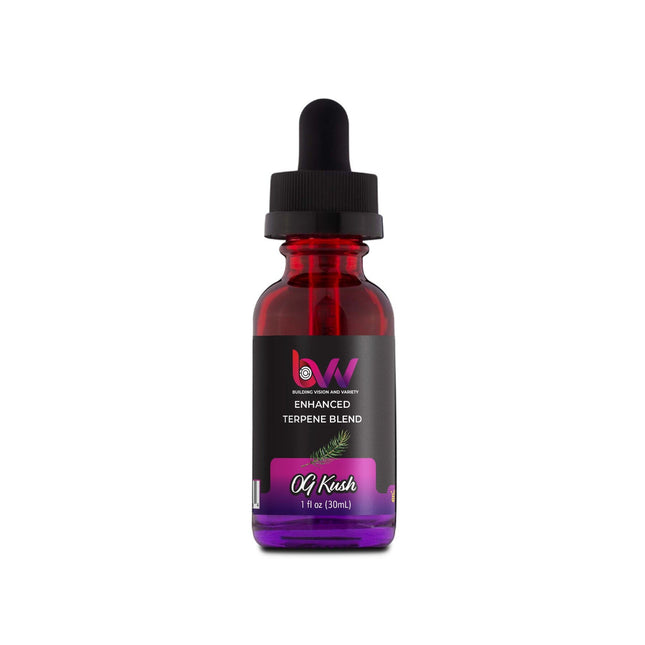
Terpenes OG Kush
BVV™ Terpenes OG Kush All sales are final. Orders can be refunded prior to fulfillment and shipping but once the order has been fulfilled and/or shipped, no refunds will be issued. Due to the hazardous nature of our product, we are unable to accept returns. BVV™ Terpenes are botanically derived terpenes enhanced with "nature-identical" artificial flavors. These flavors boost the natural flavor profile of the terpenes, providing the user with a more pleasant vaping experience. In order to provide complete transparency and elicit customer confidence, all ingredients are disclosed in the technical data sheet. BVV™ OG Kush Safety Data Sheet BVV™ OG Kush Technical Data Sheet OG Kush a hybrid strain with a distinctive earthy, pine, woody aroma, is well-known for soothing, euphoric effects. This strain has spawned several varieties Fragrance Earth, pine, wood Effect Attention, motivation, drive, and improves focus Storage Requirements: Keep in the original container, lid securely tightened and away from heat, open flames, sunlight, combustible materials, and hot surfaces. Store below 15℃ (60℉). Improper storage can cause terpenes to degrade. Dilution: Terpenes must be diluted prior to use for flavor and effect (1-5% by total volume). Terpenes are oil soluble and mix well with plant extracts, coconut oil, and more. Handle With Care: Can cause skin irritation, do not ingest PRIOR to dilution.
$14.00 - $210.05
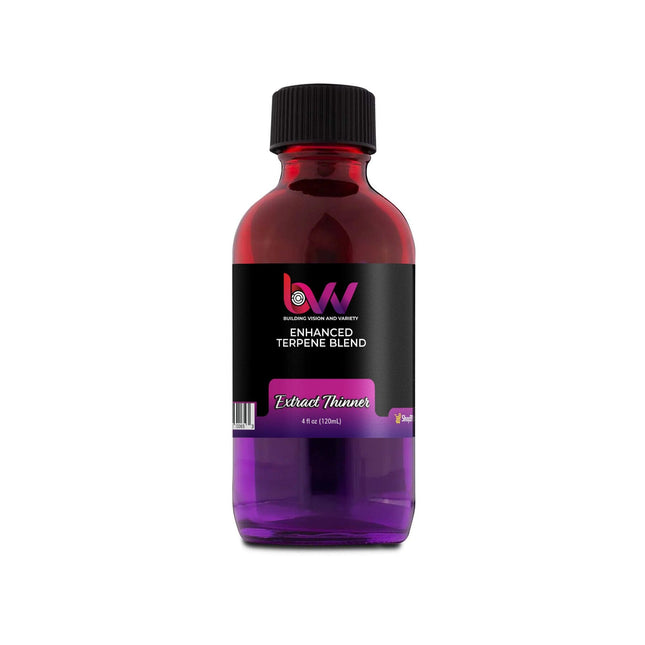
Extract Thinner *Compare to True Terpenes Viscosity
BVV™ Extract Thinner All sales are final. Orders can be refunded prior to fulfillment and shipping but once the order has been fulfilled and/or shipped, no refunds will be issued. Due to the hazardous nature of our product, we are unable to accept returns. BVV™ Extract Thinner is a diluent made from natural terpenes. It does not contain PG, VG, PEG, MCT, Squalane, Squalene, Coconut oil, Triethyl Citrate, or Vitamin E Acetate. Our Extract Thinner will combine with your terpenes and oil and is formulated to minimize flavor and aroma impact. Oure Extract Thinner is not a thickening nor cutting agent and not recommended to be used with CBD. This product is designed to be used with winterized extracts. It is a clear liquid with a faint, odor that will minimally contribute to the aroma and flavor. In order to provide complete transparency and illicit customer confidence, all ingredients are disclosed. INGREDIENTS: Phytol, Beta-Caryophyllene, D-Limonene, Farnesol and Nerolidol Dilution Use Instructions: First infuse your terpene strain or flavor into your winterized extract. Typically 1-5% by volume. Then to use the Extract thinner add 1-3% by Total Volume to thin the extract. Made in the USA by cGMP facilities ISO 9001:2015 Shelf Life: 3 Years Storage Requirements: Keep in the original container, lid securely tightened and away from heat, open flames, sunlight, combustible materials, and hot surfaces. Store in a cool dry place. Improper storage can cause terpenes to degrade.
$22.41 - $392.10
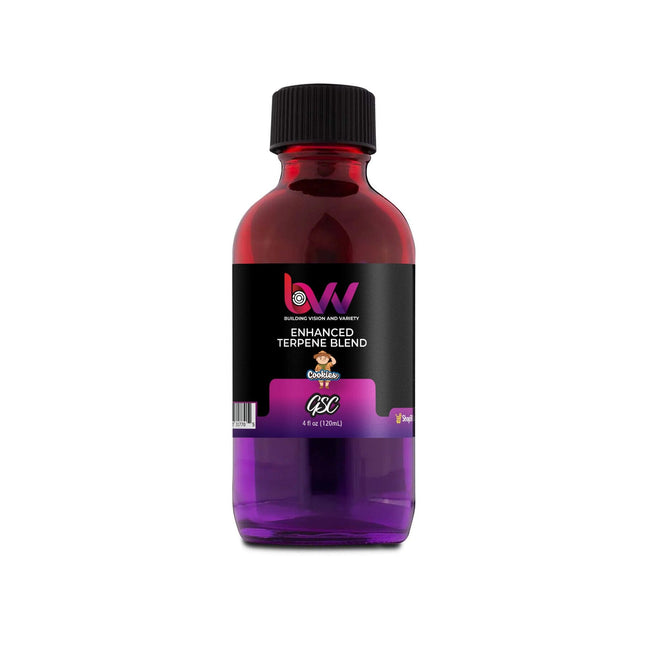
Terpenes GSC
BVV™ Terpenes GSC All sales are final. Orders can be refunded prior to fulfillment and shipping but once the order has been fulfilled and/or shipped, no refunds will be issued. Due to the hazardous nature of our product, we are unable to accept returns. BVV™ Terpenes are botanically derived terpenes enhanced with "nature-identical" artificial flavors. These flavors boost the natural flavor profile of the terpenes, providing the user with a more pleasant vaping experience. In order to provide complete transparency and elicit customer confidence, all ingredients are disclosed in the technical data sheet. BVV™ GSC Safety Data Sheet BVV™ GSC Technical Data Sheet Girl Scout Cookies or GSC is a California original and is a hybrid of OG Kush and Durban Poison. GSC has a pungent, sweet, earthy aroma and is described as giving feelings of happiness, soothing, creativity, and euphoria. Fragrance Floral, earth, spicy, sweet, pine Effect Mood elevating, Relaxing, Improves sleep, Improves focus Storage Requirements: Keep in the original container, lid securely tightened and away from heat, open flames, sunlight, combustible materials, and hot surfaces. Store below 15℃ (60℉). Improper storage can cause terpenes to degrade. Dilution: Terpenes must be diluted prior to use for flavor and effect (1-5% by total volume). Terpenes are oil soluble and mix well with plant extracts, coconut oil, and more. Handle With Care: Can cause skin irritation, do not ingest PRIOR to dilution.
$14.00 - $210.05
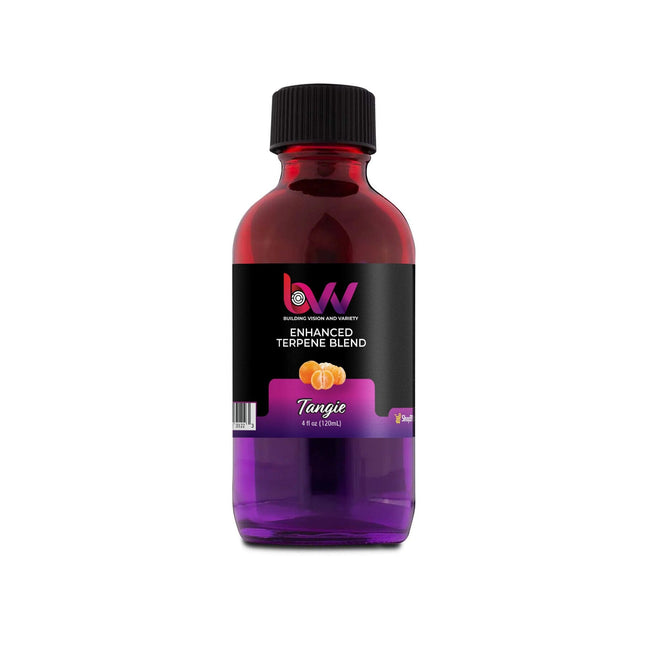
Terpenes Tangie
BVV™ Terpenes Tangie All sales are final. Orders can be refunded prior to fulfillment and shipping but once the order has been fulfilled and/or shipped, no refunds will be issued. Due to the hazardous nature of our product, we are unable to accept returns. BVV™ Terpenes are botanically derived terpenes enhanced with "nature-identical" artificial flavors. These flavors boost the natural flavor profile of the terpenes, providing the user with a more pleasant vaping experience. In order to provide complete transparency and elicit customer confidence, all ingredients are disclosed in the technical data sheet. BVV™ Tangie Safety Data Sheet BVV™ Tangie Technical Data Sheet Tangie is a sativa strain blending California Orange and a Skunk hybrid, imitates the Tangerine Dream variety popular in the 1990s. Originating in Amsterdam, this citrus, orange, sweet-smelling strain creeps with uplifting, energetic, yet soothing euphoric effects. Fragrance Earth, Citrus, Sweet Effect Promotes creativity, Energizing, Promotes relaxation. Storage Requirements: Keep in the original container, lid securely tightened and away from heat, open flames, sunlight, combustible materials, and hot surfaces. Store below 15℃ (60℉). Improper storage can cause terpenes to degrade. Dilution: Terpenes must be diluted prior to use for flavor and effect (1-5% by total volume). Terpenes are oil soluble and mix well with plant extracts, coconut oil, and more. Handle With Care: Can cause skin irritation, do not ingest PRIOR to dilution.
$14.00 - $210.05
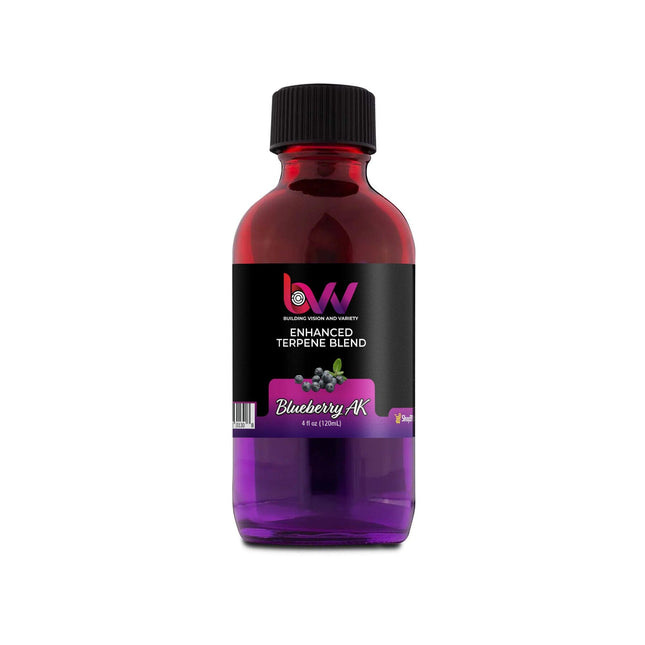
Terpenes Blueberry AK
BVV™ Terpenes Blueberry AK All sales are final. Orders can be refunded prior to fulfillment and shipping but once the order has been fulfilled and/or shipped, no refunds will be issued. Due to the hazardous nature of our product, we are unable to accept returns. BVV™ Terpenes are botanically derived terpenes enhanced with "nature-identical" artificial flavors. These flavors boost the natural flavor profile of the terpenes, providing the user with a more pleasant vaping experience. In order to provide complete transparency and elicit customer confidence, all ingredients are disclosed in the technical data sheet. BVV™ Blueberry AK Safety Data Sheet BVV™ Blueberry AK Technical Data Sheet BVV™ Food Grade Certificate Blueberry AK As the name suggests, Blueberry AK is a hybrid strain that combines the indica-dominant Blueberry with the sativa-dominant AK-47, both popular and potent strains in their own right. Blueberry AK has a strong musky odor with undertones of berry, and flavors ranging from sweet Kush to the more peppery taste of the AK. The effects of this hybrid are both relaxing and upbeat, often inducing a case of the giggles, and people have used it to treat anxiety, depression, and pain. Fragrance Earth, Citrus, Sweet Effect Mood Elevating, Relaxation, Eases Minor Pain. Storage Requirements: Keep in the original container, lid securely tightened and away from heat, open flames, sunlight, combustible materials, and hot surfaces. Store below 15℃ (60℉). Improper storage can cause terpenes to degrade. Dilution: Terpenes must be diluted prior to use for flavor and effect (1-5% by total volume). Terpenes are oil soluble and mix well with plant extracts, coconut oil, and more. Handle With Care: Can cause skin irritation, do not ingest PRIOR to dilution.
$14.00 - $210.05
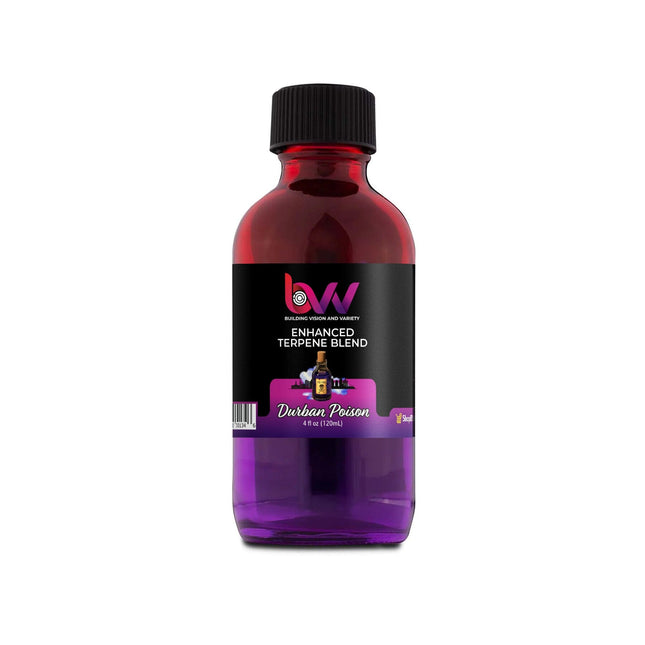
Terpenes Durban Poison
BVV™ Terpenes Durban Poison All sales are final. Orders can be refunded prior to fulfillment and shipping but once the order has been fulfilled and/or shipped, no refunds will be issued. Due to the hazardous nature of our product, we are unable to accept returns. BVV™ Terpenes are botanically derived terpenes enhanced with "nature-identical" artificial flavors. These flavors boost the natural flavor profile of the terpenes, providing the user with a more pleasant vaping experience. In order to provide complete transparency and elicit customer confidence, all ingredients are disclosed in the technical data sheet. BVV™ Durban Poison Safety Data Sheet BVV™ Durban Poison Technical Data Sheet BVV™ Food Grade Certificate BVV™ Terpenes Durban Poison Durban Poison is a pure sativa known for its energy-giving, uplifting, creative effects. It has a sweet smell and a sweet, earthy, pine flavor. Fragrance Sweet, Sour, Earth, Pine, Citrus Effect Productive, Creative Energy, Focusing Strain Storage Requirements: Keep in the original container, lid securely tightened and away from heat, open flames, sunlight, combustible materials, and hot surfaces. Store below 15℃ (60℉). Improper storage can cause terpenes to degrade. Dilution: Terpenes must be diluted prior to use for flavor and effect (1-5% by total volume). Terpenes are oil soluble and mix well with plant extracts, coconut oil, and more. Handle With Care: Can cause skin irritation, do not ingest PRIOR to dilution.
$14.00 - $210.05
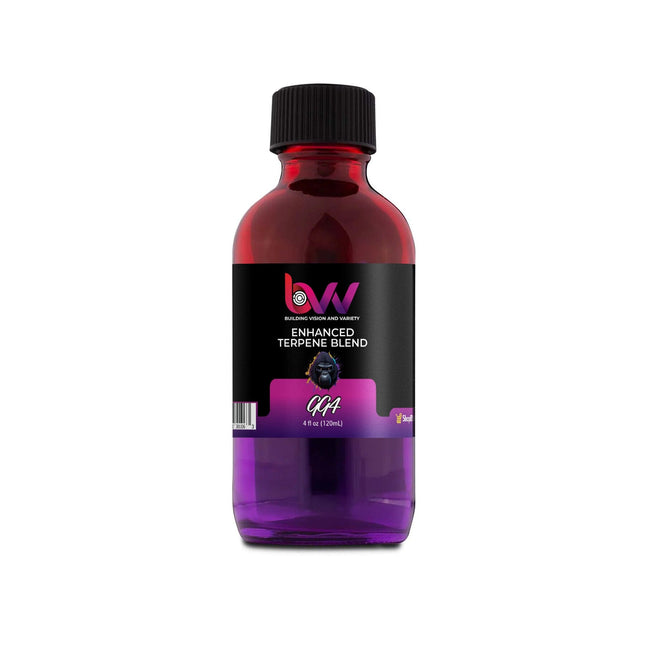
Terpenes GG4
BVV™ Terpenes GG4 All sales are final. Orders can be refunded prior to fulfillment and shipping but once the order has been fulfilled and/or shipped, no refunds will be issued. Due to the hazardous nature of our product, we are unable to accept returns. BVV™ Terpenes are botanically derived terpenes enhanced with "nature-identical" artificial flavors. These flavors boost the natural flavor profile of the terpenes, providing the user with a more pleasant vaping experience. In order to provide complete transparency and elicit customer confidence, all ingredients are disclosed in the technical data sheet. BVV™ GG4 Safety Data Sheet BVV™ GG4 Technical Data Sheet GG#4 is an award-winning hybrid strain. It is potent and indica dominant. Pungent, earthy, pine aromas accompany heavy, happy soothing effects. This strain is the offspring of Chem’s Sister, Sour Dubb, and Chocolate Diesel, and it will have you feeling “glued” to the couch. Fragrance Earth, Pine, Fuel Effect Euphoric, Soothing, Heavy and Extreme Couch-lock Storage Requirements: Keep in the original container, lid securely tightened and away from heat, open flames, sunlight, combustible materials, and hot surfaces. Store below 15℃ (60℉). Improper storage can cause terpenes to degrade. Dilution: Terpenes must be diluted prior to use for flavor and effect (1-5% by total volume). Terpenes are oil soluble and mix well with plant extracts, coconut oil, and more. Handle With Care: Can cause skin irritation, do not ingest PRIOR to dilution.
$14.00 - $210.05
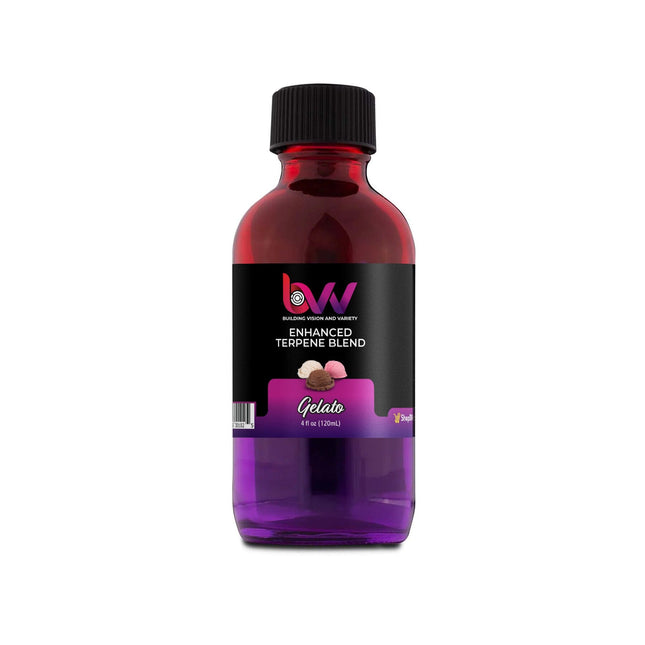
Terpenes Gelato
BVV™ Terpenes Gelato All sales are final. Orders can be refunded prior to fulfillment and shipping but once the order has been fulfilled and/or shipped, no refunds will be issued. Due to the hazardous nature of our product, we are unable to accept returns. BVV™ Terpenes are botanically derived terpenes enhanced with "nature-identical" artificial flavors. These flavors boost the natural flavor profile of the terpenes, providing the user with a more pleasant vaping experience. In order to provide complete transparency and elicit customer confidence, all ingredients are disclosed in the technical data sheet. BVV™ Gelato Safety Data Sheet BVV™ Gelato Technical Data Sheet Gelato This hybrid strain is named for its dessert-like aroma. A blend of Sunset Sherbet and Thin Mint Girl Scout Cookies, Gelato is a potent deliverer of restfulness and euphoria. Sweet, pungent, flowery scents bring creativity. Also known as “Larry Bird.” Fragrance Sweet, Pungent, Berry-Like, Creamy Effect Soothing, Euphoric, Happy, Giggly Storage Requirements: Keep in the original container, lid securely tightened and away from heat, open flames, sunlight, combustible materials, and hot surfaces. Store below 15℃ (60℉). Improper storage can cause terpenes to degrade. Dilution: Terpenes must be diluted prior to use for flavor and effect (1-5% by total volume). Terpenes are oil soluble and mix well with plant extracts, coconut oil, and more. Handle With Care: Can cause skin irritation, do not ingest PRIOR to dilution.
$14.00 - $210.05
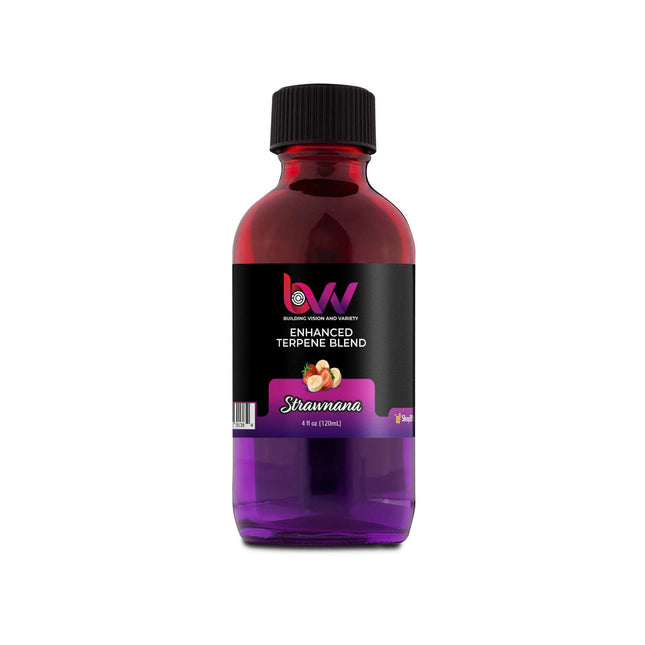
Terpenes Strawnana
BVV™ Terpenes Strawnana All sales are final. Orders can be refunded prior to fulfillment and shipping but once the order has been fulfilled and/or shipped, no refunds will be issued. Due to the hazardous nature of our product, we are unable to accept returns. BVV™ Terpenes are botanically derived terpenes enhanced with "nature-identical" artificial flavors. These flavors boost the natural flavor profile of the terpenes, providing the user with a more pleasant vaping experience. In order to provide complete transparency and elicit customer confidence, all ingredients are disclosed in the technical datasheet. BVV™ Strawnana Safety Data Sheet BVV™ Strawnana Technical Data Sheet Strawnana is a sweet berry strain is a hybrid crossing Banana Kush and Bubble Gum’s strawberry phenotype. Indica dominant, Strawnana delivers an uplifting, peaceful euphoria. Fragrance Strawberry, Sweet, Berry Effect Promotes Relaxation, Improves Sleep, Stress Relief, Mood Elevating Storage Requirements: Keep in the original container, lid securely tightened and away from heat, open flames, sunlight, combustible materials, and hot surfaces. Store below 15℃ (60℉). Improper storage can cause terpenes to degrade. Dilution: Terpenes must be diluted prior to use for flavor and effect (1-5% by total volume). Terpenes are oil soluble and mix well with plant extracts, coconut oil, and more. Handle With Care: Can cause skin irritation, do not ingest PRIOR to dilution.
$14.00 - $210.05
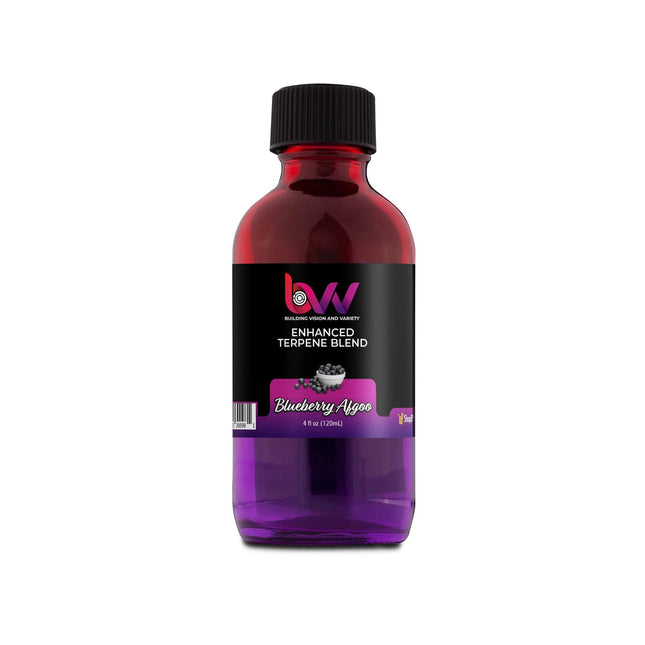
Terpenes Blueberry Afgoo
BVV™ Terpenes Blueberry Afgoo All sales are final. Orders can be refunded prior to fulfillment and shipping but once the order has been fulfilled and/or shipped, no refunds will be issued. Due to the hazardous nature of our product, we are unable to accept returns. BVV™ Terpenes are botanically derived terpenes enhanced with "nature-identical" artificial flavors. These flavors boost the natural flavor profile of the terpenes, providing the user with a more pleasant vaping experience. In order to provide complete transparency and elicit customer confidence, all ingredients are disclosed in the technical data sheet. BVV™ Blueberry Afgoo Safety Data Sheet BVV™ Blueberry Afgoo Technical Data Sheet BVV™ Food Grade Certificate Blueberry Afgoo Blueberry Afgoo is an relaxing strain that was created by crossing Blueberry and Afgoo. The Blueberry Afgoo terpene profile has a pleasing palette of pine, skunk, and berry. Fragrance Piney, Skunky, Berry Effect Promotes Relaxation, Improves Sleep, Stress Relief. Storage Requirements: Keep in the original container, lid securely tightened and away from heat, open flames, sunlight, combustible materials, and hot surfaces. Store below 15℃ (60℉). Improper storage can cause terpenes to degrade. Dilution: Terpenes must be diluted prior to use for flavor and effect (1-5% by total volume). Terpenes are oil soluble and mix well with plant extracts, coconut oil, and more. Handle With Care: Can cause skin irritation, do not ingest PRIOR to dilution.
$14.00 - $210.05
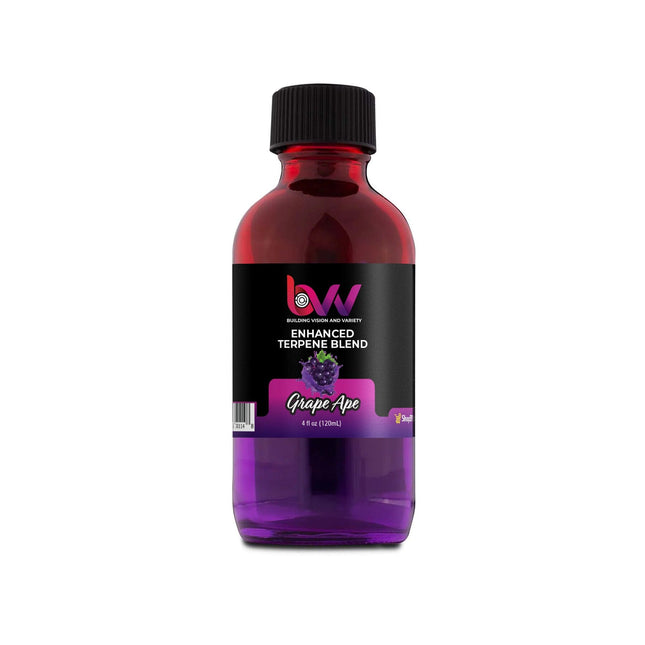
Terpenes Grape Ape
BVV™ Terpenes Grape Ape All sales are final. Orders can be refunded prior to fulfillment and shipping but once the order has been fulfilled and/or shipped, no refunds will be issued. Due to the hazardous nature of our product, we are unable to accept returns. BVV™ Terpenes are botanically derived terpenes enhanced with "nature-identical" artificial flavors. These flavors boost the natural flavor profile of the terpenes, providing the user with a more pleasant vaping experience. In order to provide complete transparency and elicit customer confidence, all ingredients are disclosed in the technical data sheet. BVV™ Grape Ape Safety Data Sheet BVV™ Grape Ape Technical Data Sheet Grape Ape: The Grape Ape cultivar that inspired our terpene profile is descended from cultivars as varied as Mendocino Purps, Skunk, and a legendary Afghani landrace. The combination of these parents has created a profile that gives the aroma of grapes, tropical fruit, earth and a pine forest. These varied smells merge into a soothing wave. Linalool and ocimene lend a hand with floral, fruity tones and enhance the chill vibe of myrcene. Fragrance Berry, Lavender, and Piney Effect Eases minor pain, Stress relieving, Soothes anxiety and tension. Storage Requirements: Keep in the original container, lid securely tightened and away from heat, open flames, sunlight, combustible materials, and hot surfaces. Store below 15℃ (60℉). Improper storage can cause terpenes to degrade. Dilution: Terpenes must be diluted prior to use for flavor and effect (1-5% by total volume). Terpenes are oil soluble and mix well with plant extracts, coconut oil, and more. Handle With Care: Can cause skin irritation, do not ingest PRIOR to dilution.
$14.00 - $210.05
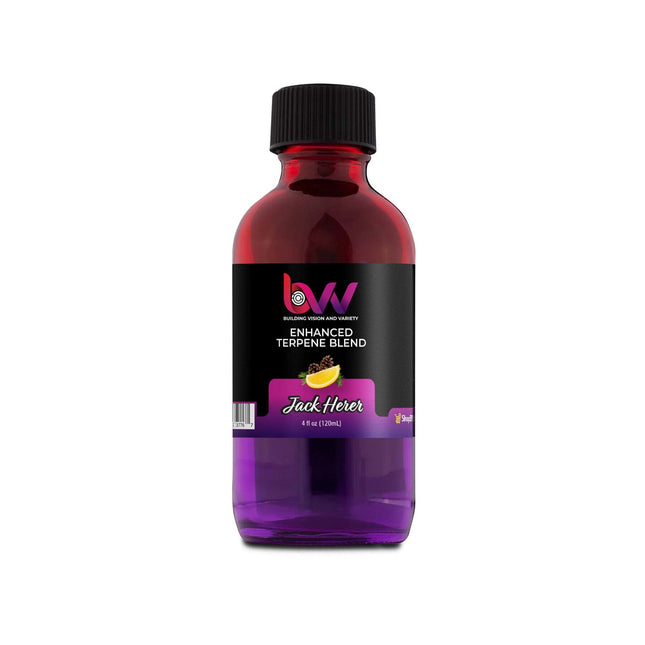
Terpenes Jack Herer
BVV™ Terpenes Jack Herer All sales are final. Orders can be refunded prior to fulfillment and shipping but once the order has been fulfilled and/or shipped, no refunds will be issued. Due to the hazardous nature of our product, we are unable to accept returns. BVV™ Terpenes are botanically derived terpenes enhanced with "nature-identical" artificial flavors. These flavors boost the natural flavor profile of the terpenes, providing the user with a more pleasant vaping experience. In order to provide complete transparency and elicit customer confidence, all ingredients are disclosed in the technical data sheet. BVV™ Jack Herer Safety Data Sheet BVV™ Jack Herer Technical Data Sheet Jack Herer: Named for a legendary activist, this profile is a legend itself. Heavy fuel aroma spills out with pepper, citrus balancing it out. Fragrance Gas, lemon and clove Effect Uplifting and insightful Storage Requirements: Keep in the original container, lid securely tightened and away from heat, open flames, sunlight, combustible materials, and hot surfaces. Store below 15℃ (60℉). Improper storage can cause terpenes to degrade. Dilution: Terpenes must be diluted prior to use for flavor and effect (1-5% by total volume). Terpenes are oil soluble and mix well with plant extracts, coconut oil, and more. Handle With Care: Can cause skin irritation, do not ingest PRIOR to dilution.
$14.00 - $210.05
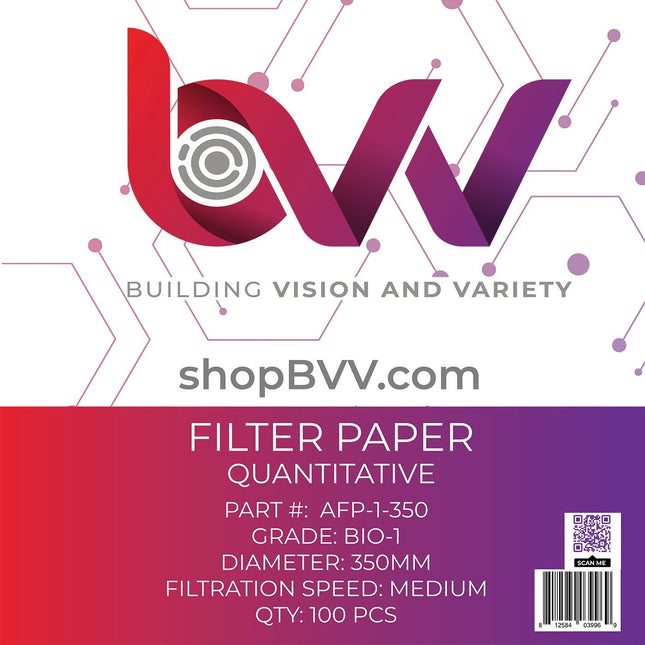
Ashless Filter Papers - 350MM - Quantitative
Ashless Filter Papers - 350MM - Quantitative Quantitative and qualitative filter papers provide laboratory grade filtration for extraction systems and are specifically used in combination with a Buchner funnel to remove fats, waxes and any other unwanted contaminants from your solution. These filter papers are used in the pre-processing stage of short path distillation to clean up the material prior to processing. Key Features: ISO 9001 Approved Manufactured from alpha-cellulose and cotton linters High Purity and low background Consistent performance Whatman equivalent quality Pre-Cut for ease of use Specifications: Classification Quantitative Sizes Available: AFP-1 11um - Medium AFP-4 20um - Fast Quantity per Pack 100 Diameter 350mm (13.78")
$133.03
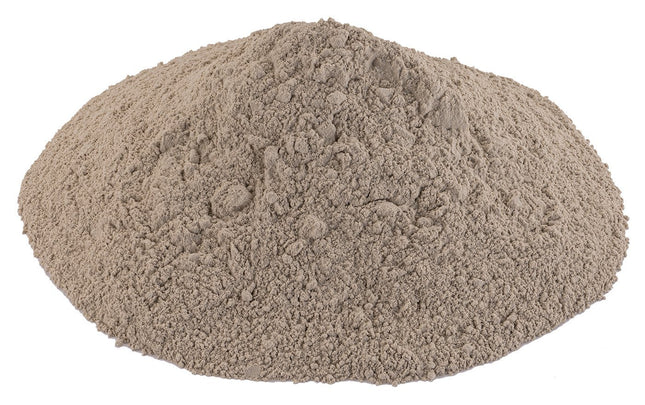
Pure-Flo® B81 Supreme Activated Bleaching & Decolorizing Bentonite for Edible Oils *FDA-GRAS (Compares to T-5™)
Pure-Flo® B81 Supreme Moderately Activated Bentonite Clay for Bleaching & Decolorizing Edible Oils pH:4.4 Pure-Flo® B81 Supreme Offers fats and oils processors surface modified performance at the best value. Excellent for oils with moderate color and chlorophyll levels. Supreme B81 adsorbent has been activated using a proprietary Surface Modification Technology (SMT). Pure-Flo® Supreme B81 Data Sheet.pdf B81 Supreme Safety Data Sheet • Excellent metals adsorption characteristics (P, Ca, Fe, Mg, Ni, etc.)• Removes color bodies from a variety of oils and effectively eliminates chlorophyll from vegetable oils• Removes soaps and phospholipids• Minimizes free fatty acid rise during bleaching• Outstanding filtration characteristics, including long filtration cycles and lesspressure build up at cycle end ph:4.4 FDA GRAS (Generally Recognized as Safe) - This product is safe for processing food, as long as its not part of the end product being consumed. NSF- HACCP *Prior to down packing this product was certified Kosher & Hallal. It does not retain its certifications after down packing, Sorry BVV™ doesn't have an on staff Rabbi or Imam on site to re-establish those certifications. Note: Bulk Bags and Bulk sizes are non-stocked items and will be ordered as needed and carry a several weeks lead time and require a forklift or pallet jack
$28.01 - $3,150.82
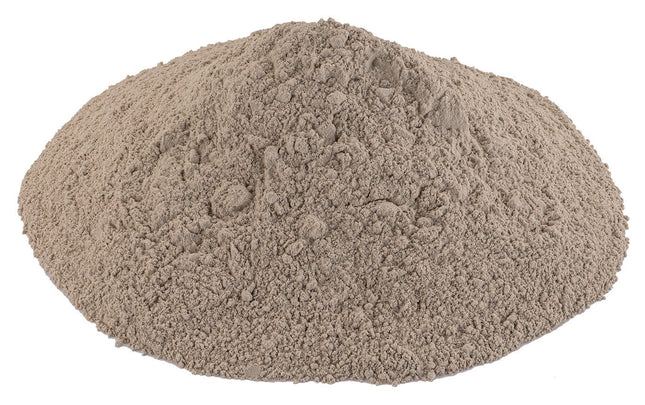
Perform 5000 Highly Acid Activated Bleaching & Decolorizing Bentonite
Pure-Flo® Perform 5000 Highly Activated Bentonite Clay for Bleaching & Decolorizing Edible Oils pH: 2.7 Pure-Flo® Perform 5000 provides superior bleaching activity for demanding oils. Effective with all types of difficult-to-bleach oil. Pure-Flo® Perform 5000 Technical Data Sheet.pdf Perform 5000 Safety Data Sheet Excellent metals adsorption characteristics (P, Ca, Fe, Mg, Ni, etc.) Excellent Chlorophyll removal Excellent Red and Blue color body removal. Removes soaps and phospholipids Outstanding filtration characteristics, including long filtration cycles and less pressure build up at cycle end. ph:2.7 FDA GRAS (Generally Recognized as Safe) - This product is safe for processing food, as long as its not part of the end product being consumed. NSF- HACCP *Prior to down packing this product was certified Kosher & Hallal. It does not retain its certifications after down packing, Sorry BVV™ doesn't have an on staff Rabbi or Imam on site to re-establish those certifications. Note: Bulk Bags and Bulk sizes are non-stocked items and will be ordered as needed and carry a several weeks lead time and require a forklift or pallet jack
$28.01 - $3,150.82
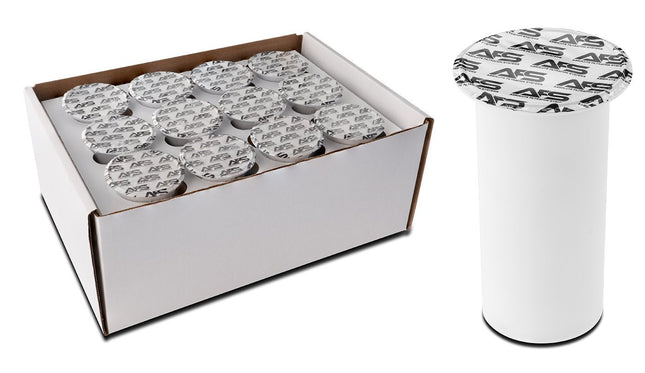
AFS 2.5" Disposable Color Remediation Cartridge
AFS Disposable Color Remediation Cartridge Note: Stainless Steel filter housing sold separately. (Click Here for Housing) AFS Instruction Manual Download Here AFS Filters are the first and only disposable color remediation filter cartridges for the botanical extraction industry. Our Patent Pending design allows for an easy to use solution implemented into existing extraction systems and is now available as a standard integration from many equipment manufacturers. AFS Filters are a simple solution that allows for the use of prepackaged filters, which are available in different recipes depending on the application. With the integrated 2.5µm paper filter molded and sealed into the cup, there is no media leak through. Pre-packed means there's no need to be an expert in remediation filter media and how to construct filters; as well as eliminates the messy process of building/packing filters yourself. Disposable offers no need for cleaning the filter housings afterward and trying to un-clog stainless filter screens. Less R&D investment, less mess, and less downtime allows for higher throughput and more profit. These come in light, medium, and heavy filtration. Learn more about each: Light Filtration is the trimmed down version of the standard Medium filter. These are best suited for extractions using fresh high-end input materials that only needs a light cleaning. Medium Filtration is our standard go-to filter. This is the most commonly used and sold filter AFS offers.. It's great for general filtration and lightening of extracted products. Heavy Filtration is packed with the highest amount of active extraction media. These filters are best suited for exceptionally dark extractions or for extractions with normal input materials where the desired outcome is closer to clear. Heavy filters offer the highest level of filtration. Technical Specifications: Life Span: 1 Time use, 5-7 lbs. of dry material. Temperature Rating: -40°C-70°C Top Seal: Induction Sealed (No glue is used) Filter: Cellulose Paper Pressure Rating: Recommended 60psi, Paper will hold 80-90 psi Max. Media: Proprietary licensed recipe. Shell Material: Polypropylene Excellent compatibility and Safe for chemicals in our industry (Butane, Propane, Ethanol). Pressure Method: Nitrogen Assist, unless you open blast CRC. Then you can assist with an air compressor. Click here to see SDS Sheet *Please recycle your spent Cartridges.
$58.82 - $739.39

Terpenes Banana Kush
BVV™ Terpenes Banana Kush All sales are final. Orders can be refunded prior to fulfillment and shipping but once the order has been fulfilled and/or shipped, no refunds will be issued. Due to the hazardous nature of our product, we are unable to accept returns. BVV™ Terpenes are botanically derived terpenes enhanced with "nature-identical" artificial flavors. These flavors boost the natural flavor profile of the terpenes, providing the user with a more pleasant vaping experience. In order to provide complete transparency and elicit customer confidence, all ingredients are disclosed in the technical data sheet. BVV™ Banana Kush Safety Data Sheet BVV™ Banana Kush Technical Data Sheet Banana Kush This sweet, tropical indica-dominant blend gives a soothed, uplifted, creative focus. Banana Kush crosses Skunk Haze and Ghost OG. The fresh banana taste will help increase happiness, better restfulness, creativity, talkativeness, and attention. Fragrance Sweet, fruity, pungent, tropical Effect Soothed, care-free, uplifted, energetic Storage Requirements: Keep in the original container, lid securely tightened and away from heat, open flames, sunlight, combustible materials, and hot surfaces. Store below 15℃ (60℉). Improper storage can cause terpenes to degrade. Dilution: Terpenes must be diluted prior to use for flavor and effect (1-5% by total volume). Terpenes are oil soluble and mix well with plant extracts, coconut oil, and more. Handle With Care: Can cause skin irritation, do not ingest PRIOR to dilution.
$14.00 - $210.05
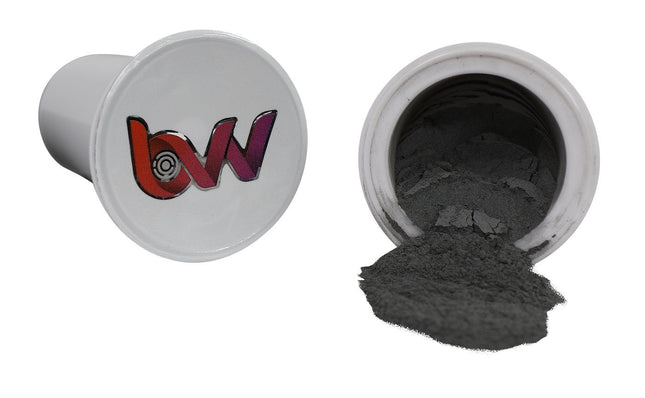
AFS Disposable Color Bleach / B80 Cartridge *FDA Certified Material
AFS Disposable Color Bleach Cartridge Note: Stainless Steel filter housing sold separately. (Click Here for Housing) AFS Instruction Manual Download Here AFS Filters are the first and only disposable color remediation filter cartridges for the botanical extraction industry. The Patent Pending design allows for an easy to use solution implemented into existing extraction systems; and is now available as a standard integration from many equipment manufacturers. AFS Filters are a simple solution that allows for the use of prepackaged filters, which are available in different recipes depending on the application. With the integrated 2.5µm paper filter molded and sealed into the cup there is no media leak through. Pre-packed means there's no need to be an expert in remediation filter media and how to construct filters; as well as eliminates the messy process of building/packing filters yourself. Disposable offers no need for cleaning the filter housings afterwards and trying to un-clog stainless filter screens. Less R&D investment, less mess, and less down time allows for higher throughput and more profit. The media contained in the BVV™ Color Bleach filter cartridge is a low pH Pure-Flo® Perform 6000 bentonite clay in a 10:1 ratio of BVV™ T-1 Activated Hardwood Carbon. Using only made in the USA materials that are FDA-GRAS and NSF certified. *The results show are using the same material for each extraction. Butane only method vs. BVV™ color bleach (110g filled Cartridge) Light Filtration is the trimmed down version of the standard Medium filter. These are best suited for extractions using fresh high end input materials that only needs a light cleaning. Medium Filtration is our standard go-to filter. This is the most commonly used and sold filter. It's great for general filtration and lightening of extracted products. Heavy Filtration is packed with the highest amount of active extraction media. These filters are best suited for exceptionally dark extractions or for extractions with normal input materials where the desired outcome is closer to clear. Heavy filters offer the highest level of filtration. Technical Specifications: Life Span: 1 Time use, Good for 5-7 lbs. of dry material. Temperature Rating: -40°C-70°C Top Seal: Induction Sealed (No glue is used) Filter: Cellulose Paper Pressure Rating: Recommended 60psi, Paper will hold 80-90 psi Max. Media: Low pH bentonite clay in a 10:1 ratio of activated 100% hardwood carbon, USA Made Materials and Certificates of Analysis available. Shell Material: Polypropylene Excellent compatibility and Safe for chemicals in our industry (Butane, Propane, Ethanol). Pressure Method: Nitrogen Assist, unless you open blast CRC. Then you can assist with an air compressor. AFS Cup weight: 48g Media Fill Volume: 110-120g Recommend Minimum Biomass: 1lb (lesser biomass will see drastic yield losses) AFS Safety Data Sheets *Please recycle your spent Cartridges. *Yield losses under refinement are to be expected but overall potency will be retained and will proportionally increase.
$77.02 - $878.03
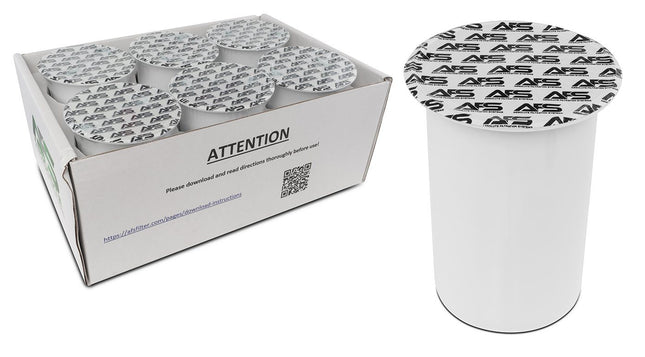
AFS 4" Disposable Color Remediation Cartridge
AFS Disposable Color Remediation Cartridge Note: Stainless Steel filter housing sold separately. (Click Here for Housing) AFS Instruction Manual Download Here AFS Filters are the first and only disposable color remediation filter cartridges for the botanical extraction industry. Our Patent Pending design allows for an easy to use solution implemented into existing extraction systems and is now available as a standard integration from many equipment manufacturers. AFS Filters are a simple solution that allows for the use of prepackaged filters, which are available in different recipes depending on the application. With the integrated 2.5µm paper filter molded and sealed into the cup, there is no media leak through. Pre-packed means there's no need to be an expert in remediation filter media and how to construct filters; as well as eliminates the messy process of building/packing filters yourself. Disposable offers no need for cleaning the filter housings afterward and trying to un-clog stainless filter screens. Less R&D investment, less mess, and less downtime allows for higher throughput and more profit. These come in light, medium, and heavy filtration. Learn more about each: Light Filtration is the trimmed down version of the standard Medium filter. These are best suited for extractions using fresh high-end input materials that only needs a light cleaning. Medium Filtration is our standard go-to filter. This is the most commonly used and sold filter AFS offers.. It's great for general filtration and lightening of extracted products. Heavy Filtration is packed with the highest amount of active extraction media. These filters are best suited for exceptionally dark extractions or for extractions with normal input materials where the desired outcome is closer to clear. Heavy filters offer the highest level of filtration. Technical Specifications: Life Span: 1 Time use, 5-7 lbs. of dry material. Temperature Rating: -40°C-70°C Top Seal: Induction Sealed (No glue is used) Filter: Cellulose Paper Pressure Rating: Recommended 60psi, Paper will hold 80-90 psi Max. Media: Proprietary licensed recipe. Shell Material: Polypropylene Excellent compatibility and Safe for chemicals in our industry (Butane, Propane, Ethanol). Pressure Method: Nitrogen Assist, unless you open blast CRC. Then you can assist with an air compressor. *Please recycle your spent Cartridges.
$98.03 - $504.13
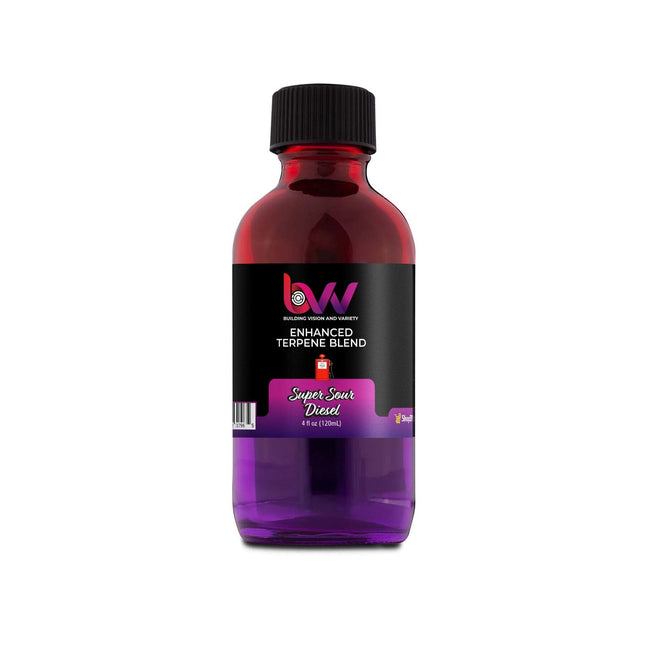
Terpenes Super Sour Diesel
BVV™ Terpenes Super Sour Diesel All sales are final. Orders can be refunded prior to fulfillment and shipping but once the order has been fulfilled and/or shipped, no refunds will be issued. Due to the hazardous nature of our product, we are unable to accept returns. BVV™ Terpenes are botanically derived terpenes enhanced with "nature-identical" artificial flavors. These flavors boost the natural flavor profile of the terpenes, providing the user with a more pleasant vaping experience. In order to provide complete transparency and elicit customer confidence, all ingredients are disclosed in the technical data sheet. BVV™ Super Sour Diesel Safety Data Sheet BVV™ Super Sour Diesel Technical Data Sheet Super Sour Diesel This potent sativa is a good choice for daytime use, although may be overpowering for new users. Effects of soothing, focus and happiness are almost immediate. Super Sour Diesel is a cross between Super Silver Haze and Sour Diesel with a pungent, earthy, diesel aroma producing energetic and creative effects. Fragrance Pungent, earthy, diesel Effect Serene, focused, joyful, fosters creativity Storage Requirements: Keep in the original container, lid securely tightened and away from heat, open flames, sunlight, combustible materials, and hot surfaces. Store below 15℃ (60℉). Improper storage can cause terpenes to degrade. Dilution: Terpenes must be diluted prior to use for flavor and effect (1-5% by total volume). Terpenes are oil soluble and mix well with plant extracts, coconut oil, and more. Handle With Care: Can cause skin irritation, do not ingest PRIOR to dilution.
$14.00 - $210.05
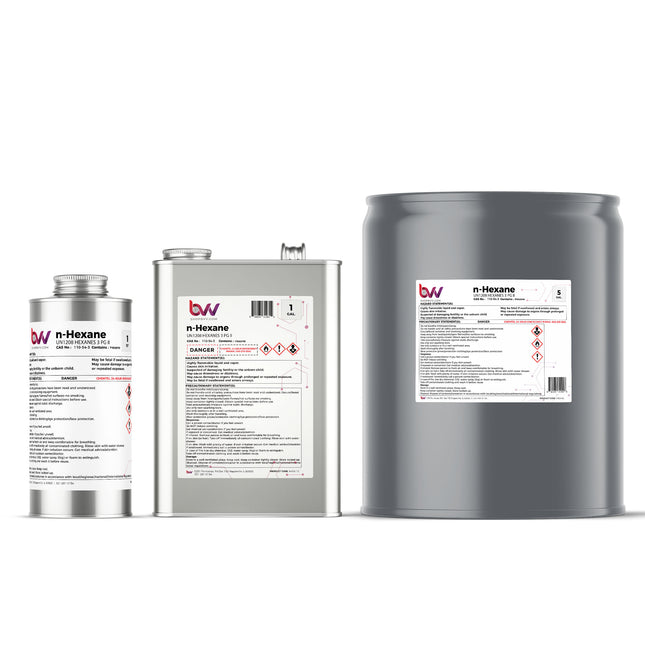
N-Hexane 99.5% Lab Grade
BVV™ Ultra High Purity Lab Grade N-Hexane HAZMAT ITEMS ARE NON-REFUNDABLE. ALL SALES ARE FINAL (Note: Container style and color may vary) BVV™ Ultra High Purity Lab Grade N-Hexane is a perfect solution for cleaning up and clarifying the extracted material and removing the green colored plant material and some waxes out of the product to produce a cleaner end result when distilling extracts. n-Hexane Safety Data Sheet Chemical Formula: C6H14 Molecular Weight: 86.178 g·mol−1 CAS Registry Number: 110-54-3 Appearance Colorless Liquid Odor: Petrolic Density 0.6606 g mL−1 Boiling Point: 68.5 °C / 155.2 °F Solubility in water: 9.5 mg L−1 GHS Pictograms: GHS Signal Word: Danger GHS Hazard Statements: H225, H302, H305, H315, H336, H361fd, H373, H411 GHS Precautionary Statements P201, P202, P210, P233, P235, P240, P241, P242, P243, P260, P264, P271, P273, P280, P281, P301+P330+P331, P302+P352, P303+P361+P353, P304+P340, P308+P313, P310, P312, P314, P332+P313, P363, P370+P378, P391, P403+P233, P405, P501 UN Identification Number: 1208 Proper Shipping Name: Hexanes Transport Hazard Class: 3 Packing Group: II DOT Placard:
$40.61 - $1,295.34
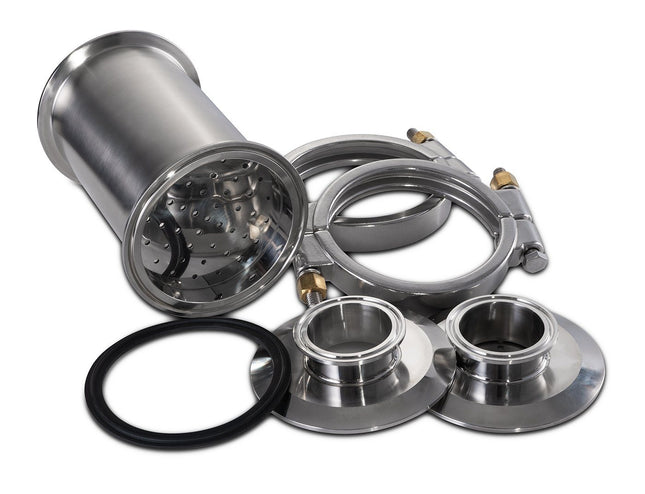
AFS 4" Tri-Clamp Inline Filter Housing for Disposable Color Remediation Cartridges
AFS Tri-Clamp Inline Filter Housing for Disposable Color Remediation Cartridges Note: Disposable cartridges sold separately. (Click Here for Cartridges) This inline housing allows for implementation of the AFS filters into many extraction systems. The AFS filter housing is 4" but comes with the adapter flanges for both ends to go inline with a standard 2" tri-clamp system. Kit Includes 2x 4" High Pressure Clamps 1x 4" Buna-N Gasket 2x Flat Reducers 4" to 2" Tri-Clamp 1x Cartridge Housing AFS Instruction Manual Download Here AFS SDS Sheet
$278.67$231.06
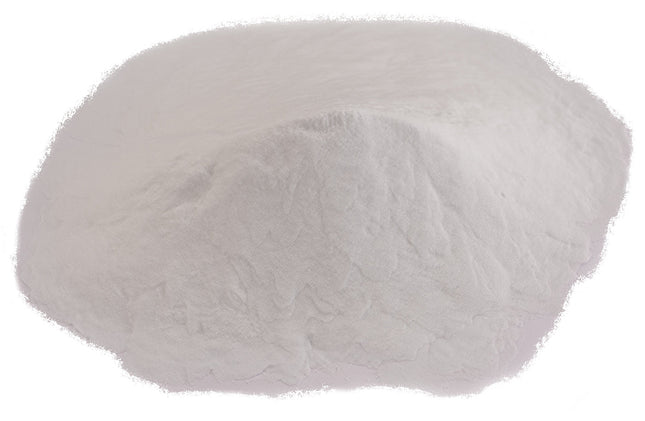
CANA-SIL60™ Silica Gel 60A Chromatographic Grade 40-63 micron (230-400 Mesh)
CANA-SIL60™ Silica Gel Silicon Dioxide 60A Chromatographic, Extraction CRC Grade Cana-Sil™ is an Optimized silica gel for extractions. This powdered silica gel (silicon dioxide) for use in chromatography batch extractions and decolorizations. Cana-Sil60 can also be used as a general adsorbent for impurities. Optimized particle size, surface area, pH, and purity make it a particularly useful material for the separation of small molecules, peptides, lipids, alkaloids, and a variety of other compounds. Silica Gel is particularly useful to use layered on top of your bentonite to remove plant gums and waxes. CANA-SIL60 Technical Data Sheet CANA-SIL60 Safety Data Sheet CANA-SIL60 Certificate of Analysis Key Specs: Particle Size: 40-63 Micron (230-400 Mesh) Pore Volume: 0.6-0.8 mL/g Loss on Drying: ≤ 2.0 wt% pH: 6.5-7.5 Empirical Formula: SiO2 Use: Chromatography Purification Hazard Statement: No ingredients are hazardous according to OSHA criteria CAS# 112926-00-8
$39.21 - $11,342.96
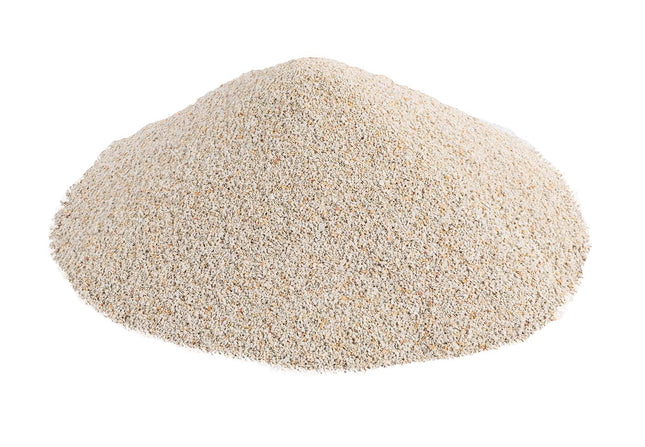
Carbon Chemistry APG Granular (ZeoClear Y)
Carbon Chemistry APG Granular (ZeoClear Y) A selective zeolitic clay adsorbent designed for precise separation control. This thermally activated attapulgite-zeolite composite features a unique alkaline surface chemistry that provides measured adsorption rates, making it ideal for gentle refinement processes. Its carefully engineered pore structure and granular stability allow for controlled removal of specific compounds while preserving desired characteristics of the process stream. Key Features: Micron Size 250-595um Attapulgite granular media, alkaline medium Easy handling, fast flow, color improvement General product improvement with high contaminant absorptivity Color Remediation In-Line Filtration Hot Scrub Recirculate Granular Media FAQ: How do I use granular media? Zeolite adsorbents can be used inline during extraction with LPG solvents or in a hot scrub with non-polar solvents of higher BP like Heptane Is this a replacement for powders? The answer depends on what your processing goals are e.g. color removal, pesticide remediation, etc. Each adsorbent for filtration media will have its own unique set of properties including pH, pore size, polarity, surface area that make certain adsorbents more suitable to certain uses. Can I mix granular media and powders? Yes, you can either mix powders with granular media or place the granular media on top a bed of powdered media. This will however result in a more restricted flow which will require additional pressure to pass your solution through your filter cake. Do I need to bake the media? Media does not need to be baked prior to use but can be only superficial water will be removed which may improve performance. To remove superficial moisture, bake for 8hrs at 200C (392F) How do I know how much media to use? This will depend on a few variables such as the amount of your starting material, the age of your starting material, and desired color of your final product. How does the media need to be stored? before and after use. Before use; Keep container tightly closed and dry; store in a cool place. After use; Store in a well-ventilated area, this media is saturated with flammable/explosive solvent and can self-ignite if not not handled properly. Is the media safe to handle without PPE (Personal Protective Equipment)? Breathing must be protected when large quantities are decanted without local exhaust ventilation. When workers face exposure to dust exceeding the occupational exposure limits they must use appropriate certified respirators. Wear a NIOSH-certified (or equivalent) particulate respirator. What micron size filters are required? / The media is larger but are there fines? The media might be large but there are fine dust particles (about 5 million per lb.) that can get carried away in your solution and require separation. We suggest stacking a 5-micron filter on top of a 1-micron filter which will help keep your flow slow as well as filtering out any fine dust particles. The media didn't work, what did I do wrong? There is an exceptionally good chance you did not restrict your solvent flow enough. Try again with a much slower flow through your filter. Another variable you might consider adjusting is solvent temperature. Colder solvent will pull less lipids and waxes which can impede the efficiency of the adsorbent. Note: Bulk Bags and Bulk sizes are non-stocked items and will be ordered as needed and carry a several week lead time and require a forklift or pallet jack
$56.01 - $11,202.92
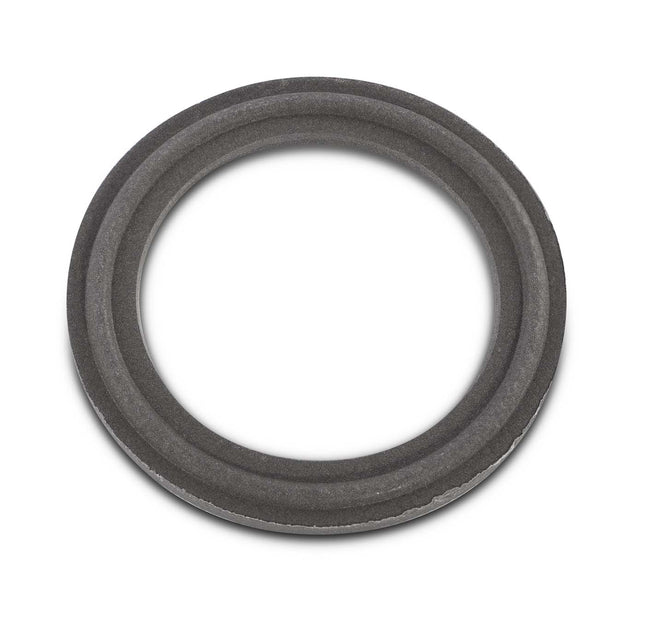
Tef-Steel 316LStainless Steel / PTFE Sanitary Tri-Clamp Gasket
Tef-Steel 316L Stainless Steel / PTFE Sanitary Tri-Clamp Gasket Tef-Steel: a 50/50 blend of modified PTFE and 316L atomized and passivated stainless steel, Tef-Steel delivers leak-proof, perfect surface performance with outstanding durability in SIP (steam in place), CIP (clean in place), WFI (water for injection) and hot oil applications. Tef-Steel is ideal for sanitary steam pipe connections in extreme temperatures ranging from -300°F to 500°F. The superior strength of Tef-Steel provides extended uptime because it eliminates cold flow and creep preventing maintenance problems and downtime. Key Features: Excellent resistance to almost all chemicals Excellent Temperature Range (-300°F to 500°F) Excellent Cleanability due to PTFE (Teflon) and Stainless Steel Sizes Available: 1" 1.5" 2" 2.5" 3" 4" 6" 8" 10" 12" Chemical Compatibility: Butane A - Excellent Propane (liquified) A - Excellent Alcohols: Amyl A - Excellent Benzyl A - Excellent Butyl A - Excellent Diacetone A - Excellent Ethyl A - Excellent Hexyl A - Excellent Isobutyl A - Excellent Isopropyl A - Excellent Methyl A - Excellent Octyl A - Excellent Propyl A - Excellent
$9.80 - $343.09
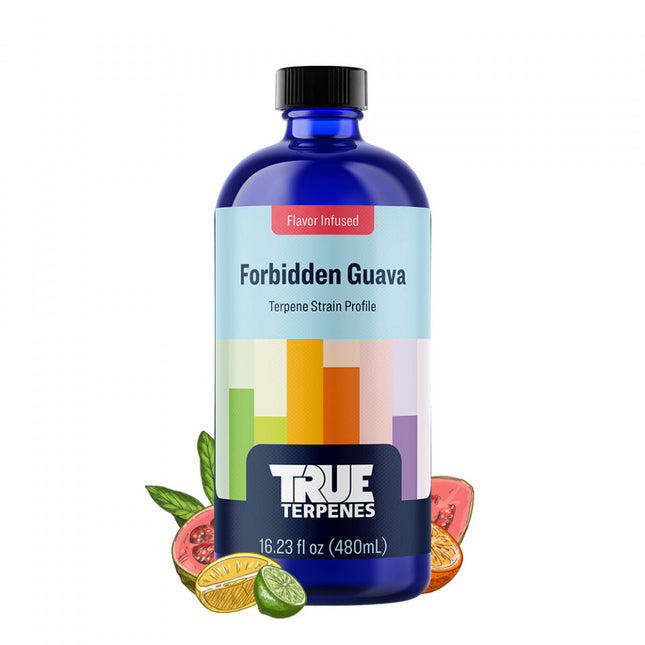
True Terpenes Forbidden Guava
True Terpenes Forbidden Guava Fragrance: Hybrid Fruity Citrus Effects: Rest Calm Bold and juicy, Forbidden Guava fills the nose with guava, cherry, and papaya. The complex profile marries sweetness, warm florals, and a distinctly tropical richness, from the aroma’s yeasty cheese base. Storage Requirements: Keep in original container, lid securely tightened and away from heat, open flames, sunlight, combustible materials and hot surfaces. No Smoking. Store in a cool dry place. Improper storage can cause terpenes to degrade. Dilution: Terpene Strain & Flavor-Infused Strain Profiles, Effects-Based Terpene Profiles & Terpene Flavors:The Terpene products above must be diluted prior to use. (1-5% by total volume). Terpenes are oil soluble and mix well with plant extracts, coconut oil, and more. Viscosity Extract Modifier: The Terpene product above must be diluted prior to use. (1-3% by total volume). Terpenes are oil soluble and mix well with plant extracts, coconut oil, and more. Handle With Care: Can cause skin irritation, do not use PRIOR to dilution. Forbidden Guava-Specific Certificates: Product Specification Certificate of Analysis Safety Data Sheet Food Safety Company-Specific Certificates: ISO 9001:2015 GMP Certification FSSC 22000
$170.14 - $3,150.82
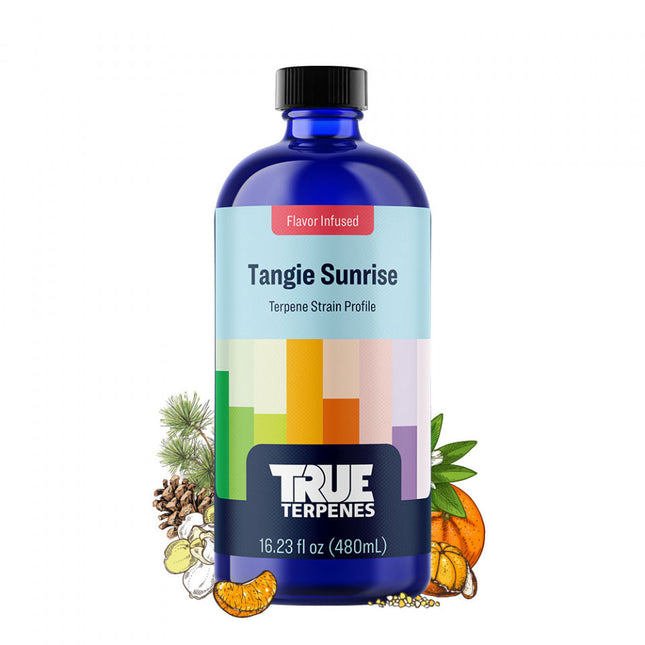
True Terpenes Tangie Sunrise
True Terpenes Tangie Sunrise Fragrance: Floral Fruity Effects: Creative Focus A burst of fresh lemon skin leads this fresh, bright flavor experience, followed by clean, piney notes, herbaceous green aromas, and a light floral background. Storage Requirements: Keep in original container, lid securely tightened and away from heat, open flames, sunlight, combustible materials and hot surfaces. No Smoking. Store in a cool dry place. Improper storage can cause terpenes to degrade. Dilution: Terpene Strain & Flavor-Infused Strain Profiles, Effects-Based Terpene Profiles & Terpene Flavors:The Terpene products above must be diluted prior to use. (1-5% by total volume). Terpenes are oil soluble and mix well with plant extracts, coconut oil, and more. Viscosity Extract Modifier: The Terpene product above must be diluted prior to use. (1-3% by total volume). Terpenes are oil soluble and mix well with plant extracts, coconut oil, and more. Handle With Care: Can cause skin irritation, do not use PRIOR to dilution. Tangie Sunrise-Specific Certificates: Product Specification Certificate of Analysis Safety Data Sheet Food Safety Company-Specific Certificates: ISO 9001:2015 GMP Certification FSSC 22000
$189.05 - $3,150.82
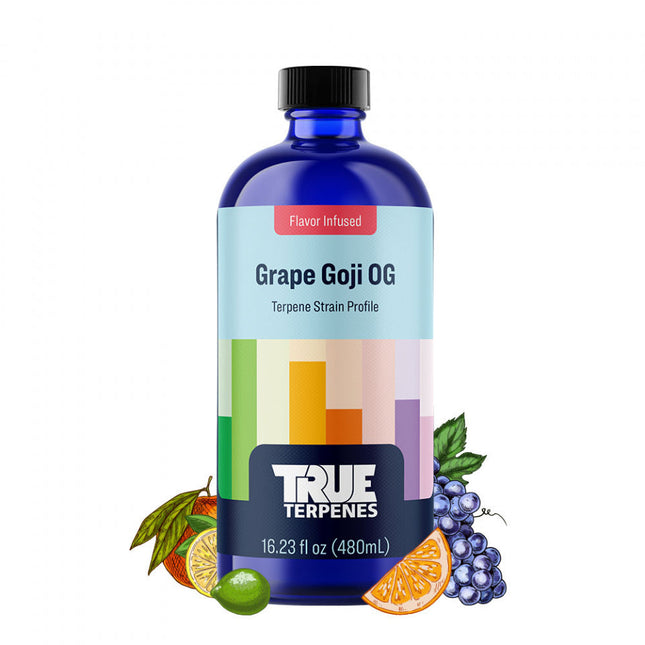
True Terpenes Grape Goji OG
True Terpenes Grape Goji OG Fragrance: Fruity Citrus Effects: Uplift Creative Super loud and sugar sweet grape flavor is underpinned with a cooling light rose aroma. Storage Requirements: Keep in original container, lid securely tightened and away from heat, open flames, sunlight, combustible materials and hot surfaces. No Smoking. Store in a cool dry place. Improper storage can cause terpenes to degrade. Dilution: Terpene Strain & Flavor-Infused Strain Profiles, Effects-Based Terpene Profiles & Terpene Flavors:The Terpene products above must be diluted prior to use. (1-5% by total volume). Terpenes are oil soluble and mix well with plant extracts, coconut oil, and more. Viscosity Extract Modifier: The Terpene product above must be diluted prior to use. (1-3% by total volume). Terpenes are oil soluble and mix well with plant extracts, coconut oil, and more. Handle With Care: Can cause skin irritation, do not use PRIOR to dilution. Grape Goji OG-Specific Certificates: Product Specification Certificate of Analysis Safety Data Sheet Food Safety Company-Specific Certificates: ISO 9001:2015 GMP Certification FSSC 22000
$170.14 - $3,150.82
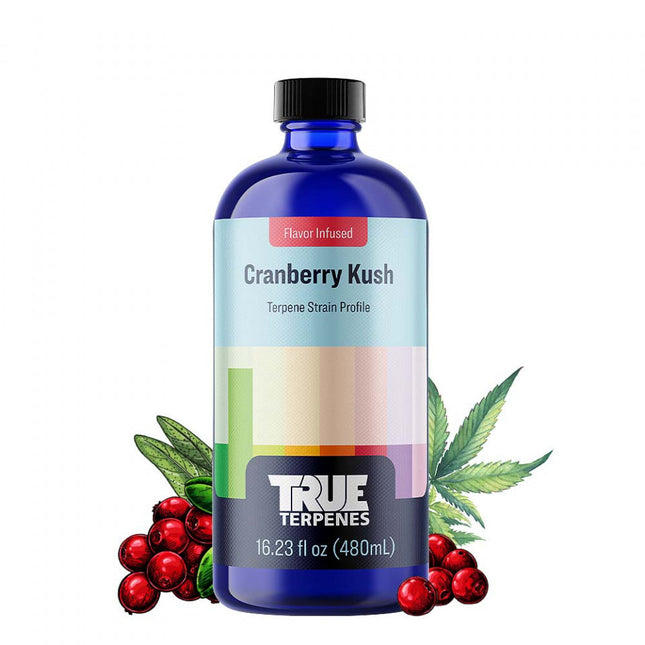
True Terpenes Cranberry Kush
True Terpenes Cranberry Kush Fragrance: Lime Berry Fruit Tones Effects: Soothing Uplifting Distinctly herbal with a tart cranberry base that’s balanced with the sweetness of white grape. Berry bush scents provide the finishing touches on this soon-to-be popular profile. Storage Requirements: Keep in original container, lid securely tightened and away from heat, open flames, sunlight, combustible materials and hot surfaces. No Smoking. Store in a cool dry place. Improper storage can cause terpenes to degrade. Dilution: Terpene Strain & Flavor-Infused Strain Profiles, Effects-Based Terpene Profiles & Terpene Flavors:The Terpene products above must be diluted prior to use. (1-5% by total volume). Terpenes are oil soluble and mix well with plant extracts, coconut oil, and more. Viscosity Extract Modifier: The Terpene product above must be diluted prior to use. (1-3% by total volume). Terpenes are oil soluble and mix well with plant extracts, coconut oil, and more. Handle With Care: Can cause skin irritation, do not use PRIOR to dilution. Cranberry Kush-Specific Certificates: Product Specification Certificate of Analysis Safety Data Sheet Food Safety Company-Specific Certificates: ISO 9001:2015 GMP Certification FSSC 22000
$170.14 - $3,150.82
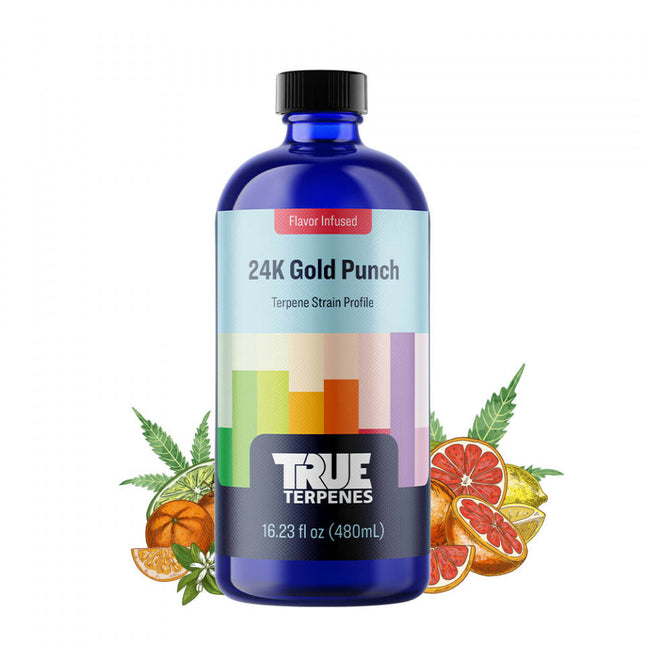
True Terpenes 24K Gold Punch
True Terpenes 24K Gold Punch Fragrance: Sweet Coconut Tropical Fruit Effects: Relaxing Happy Uplifting With hints of grapefruit, citrus and fruit punch, our Flavor Infused take on this classic is a show stopper in both the scent and flavor department. Storage Requirements: Keep in original container, lid securely tightened and away from heat, open flames, sunlight, combustible materials and hot surfaces. No Smoking. Store in a cool dry place. Improper storage can cause terpenes to degrade. Dilution: Terpene Strain & Flavor-Infused Strain Profiles, Effects-Based Terpene Profiles & Terpene Flavors:The Terpene products above must be diluted prior to use. (1-5% by total volume). Terpenes are oil soluble and mix well with plant extracts, coconut oil, and more. Viscosity Extract Modifier: The Terpene product above must be diluted prior to use. (1-3% by total volume). Terpenes are oil soluble and mix well with plant extracts, coconut oil, and more. Handle With Care: Can cause skin irritation, do not use PRIOR to dilution. 24K Gold Punch-Specific Certificates: Product Specification Certificate of Analysis Safety Data Sheet Food Safety Company-Specific Certificates: ISO 9001:2015 GMP Certification FSSC 22000
$170.14 - $3,150.82

True Terpenes Biscotti
True Terpenes Biscotti Fragrance: Sweet Earthy Baked Goods Biscut Effects: Relaxed Creative Buzzy from Head to Toe Our new Flavor Infused Biscotti profile is like walking into a warm bakery on a cool winter day. Notes of cake, pastries and fresh baked sugar cookies exude from this incredible new profile. Storage Requirements: Keep in original container, lid securely tightened and away from heat, open flames, sunlight, combustible materials and hot surfaces. No Smoking. Store in a cool dry place. Improper storage can cause terpenes to degrade. Dilution: Terpene Strain & Flavor-Infused Strain Profiles, Effects-Based Terpene Profiles & Terpene Flavors:The Terpene products above must be diluted prior to use. (1-5% by total volume). Terpenes are oil soluble and mix well with plant extracts, coconut oil, and more. Viscosity Extract Modifier: The Terpene product above must be diluted prior to use. (1-3% by total volume). Terpenes are oil soluble and mix well with plant extracts, coconut oil, and more. Handle With Care: Can cause skin irritation, do not use PRIOR to dilution. Biscotti-Specific Certificates: Product Specification Certificate of Analysis Safety Data Sheet Food Safety Company-Specific Certificates: ISO 9001:2015 GMP Certification FSSC 22000
$189.05 - $3,150.82
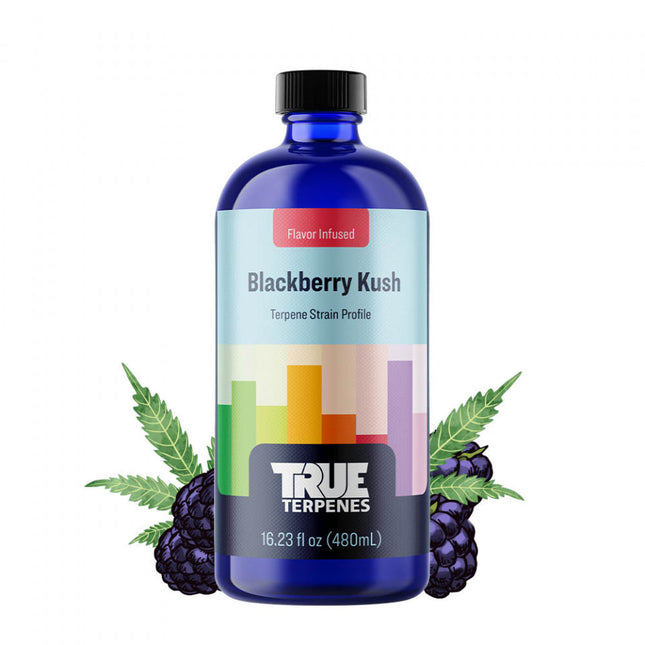
True Terpenes Blackberry Kush
True Terpenes Blackberry Kush Fragrance: Dark Berry Fruity Woody Effects: Relaxing Happy Sleepy Fruit and gas combine in an intense infusion of juicy berry notes with a strong and complex gas profile. First you get a blast of fresh blackberries, second a whoosh of fresh greens. Refreshing and bold, this new Profile is the perfect full-bodied blend! Storage Requirements: Keep in original container, lid securely tightened and away from heat, open flames, sunlight, combustible materials and hot surfaces. No Smoking. Store in a cool dry place. Improper storage can cause terpenes to degrade. Dilution: Terpene Strain & Flavor-Infused Strain Profiles, Effects-Based Terpene Profiles & Terpene Flavors:The Terpene products above must be diluted prior to use. (1-5% by total volume). Terpenes are oil soluble and mix well with plant extracts, coconut oil, and more. Viscosity Extract Modifier: The Terpene product above must be diluted prior to use. (1-3% by total volume). Terpenes are oil soluble and mix well with plant extracts, coconut oil, and more. Handle With Care: Can cause skin irritation, do not use PRIOR to dilution. Blackberry Kush-Specific Certificates: Product Specification Certificate of Analysis Safety Data Sheet Food Safety Company-Specific Certificates: ISO 9001:2015 GMP Certification FSSC 22000
$170.14 - $3,150.82
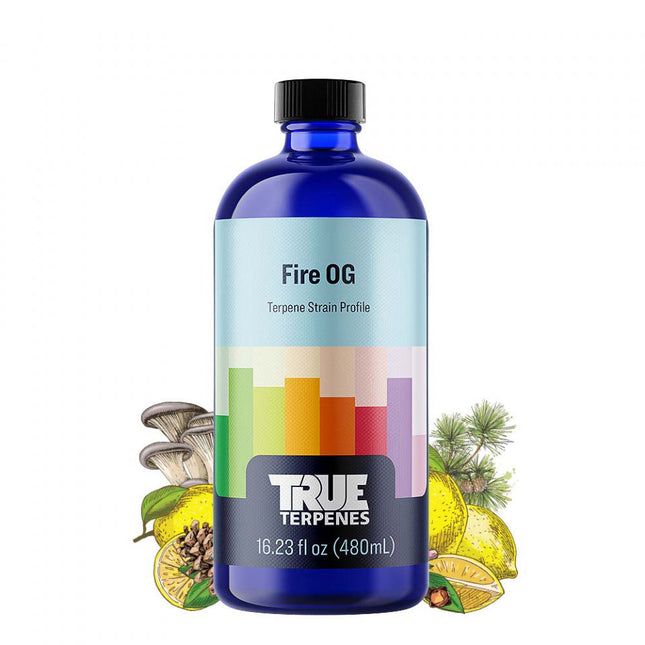
True Terpenes Fire OG
True Terpenes Fire OG Fragrance: Lemon Earth Pine Effects: Couch-Lock End of Day Soothing Fire OG is descended from a crossing of California’s SFV OG and the original OG Kush. This profile is known for its ability to put you on the couch. Citrus tones distinguish this from the classic OG Kush, but the typical OG earthy, musk and pine notes are present as well. Storage Requirements: Keep in original container, lid securely tightened and away from heat, open flames, sunlight, combustible materials and hot surfaces. No Smoking. Store in a cool dry place. Improper storage can cause terpenes to degrade. Dilution: Terpene Strain & Flavor-Infused Strain Profiles, Effects-Based Terpene Profiles & Terpene Flavors:The Terpene products above must be diluted prior to use. (1-5% by total volume). Terpenes are oil soluble and mix well with plant extracts, coconut oil, and more. Viscosity Extract Modifier: The Terpene product above must be diluted prior to use. (1-3% by total volume). Terpenes are oil soluble and mix well with plant extracts, coconut oil, and more. Handle With Care: Can cause skin irritation, do not use PRIOR to dilution. Fire OG-Specific Certificates: Product Specification Certificate of Analysis Safety Data Sheet Food Safety Company-Specific Certificates: ISO 9001:2015 GMP Certification FSSC 22000
$170.14 - $3,150.82
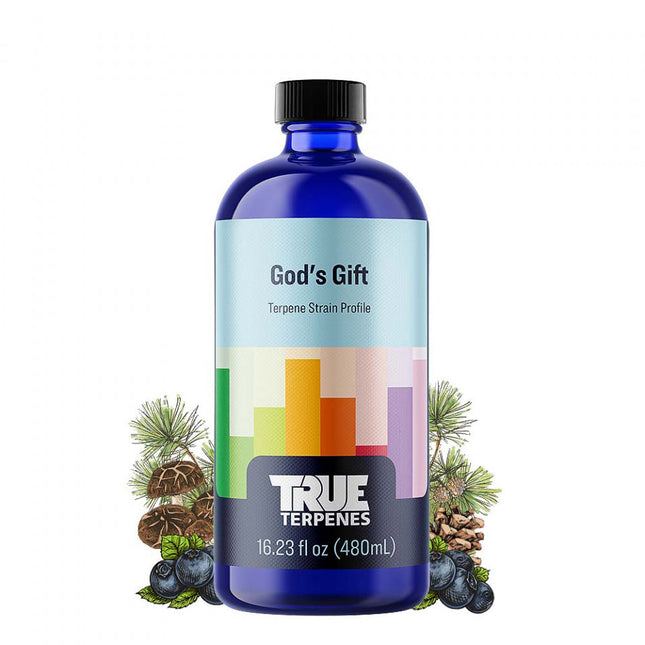
True Terpenes God's Gift
True Terpenes God's Gift Fragrance: Earthy Pine Berry Effects: Soothing Couch-Lock God’s Gift is as the name implies descended from heaven. It’ll put your head in the clouds. Earthy musk and pine aromas mix with a floral, berry sweetness. Storage Requirements: Keep in original container, lid securely tightened and away from heat, open flames, sunlight, combustible materials and hot surfaces. No Smoking. Store in a cool dry place. Improper storage can cause terpenes to degrade. Dilution: Terpene Strain & Flavor-Infused Strain Profiles, Effects-Based Terpene Profiles & Terpene Flavors:The Terpene products above must be diluted prior to use. (1-5% by total volume). Terpenes are oil soluble and mix well with plant extracts, coconut oil, and more. Viscosity Extract Modifier: The Terpene product above must be diluted prior to use. (1-3% by total volume). Terpenes are oil soluble and mix well with plant extracts, coconut oil, and more. Handle With Care: Can cause skin irritation, do not use PRIOR to dilution. God's Gift-Specific Certificates: Product Specification Certificate of Analysis Safety Data Sheet Food Safety Company-Specific Certificates: ISO 9001:2015 GMP Certification FSSC 22000
$170.14 - $3,150.82
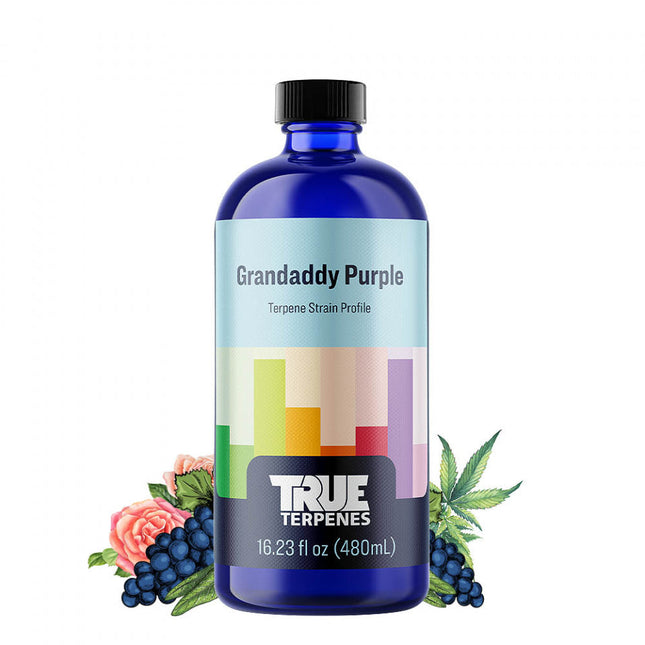
True Terpenes Grandaddy Purple
True Terpenes Grandaddy Purple Fragrance: Sweet Floral Earth Effects: Soothed Tired Hungry Euphoria Grandaddy Purple (GDP) is a low from California with deep purple blooms. It is a cross between Big Bud and Purple Urkle. The effects of this sweet, grape/berry flavored, powerful strain are both euphoric and soothing. In addition to feeling soothed, patients describe feeling tired, happy, and hungry. Storage Requirements: Keep in original container, lid securely tightened and away from heat, open flames, sunlight, combustible materials and hot surfaces. No Smoking. Store in a cool dry place. Improper storage can cause terpenes to degrade. Dilution: Terpene Strain & Flavor-Infused Strain Profiles, Effects-Based Terpene Profiles & Terpene Flavors:The Terpene products above must be diluted prior to use. (1-5% by total volume). Terpenes are oil soluble and mix well with plant extracts, coconut oil, and more. Viscosity Extract Modifier: The Terpene product above must be diluted prior to use. (1-3% by total volume). Terpenes are oil soluble and mix well with plant extracts, coconut oil, and more. Handle With Care: Can cause skin irritation, do not use PRIOR to dilution. Grandaddy Purple-Specific Certificates: Product Specification All Natural Certificate of Analysis Safety Data Sheet Food Safety Company-Specific Certificates: ISO 9001:2015 GMP Certification FSSC 22000
$170.14 - $3,150.82
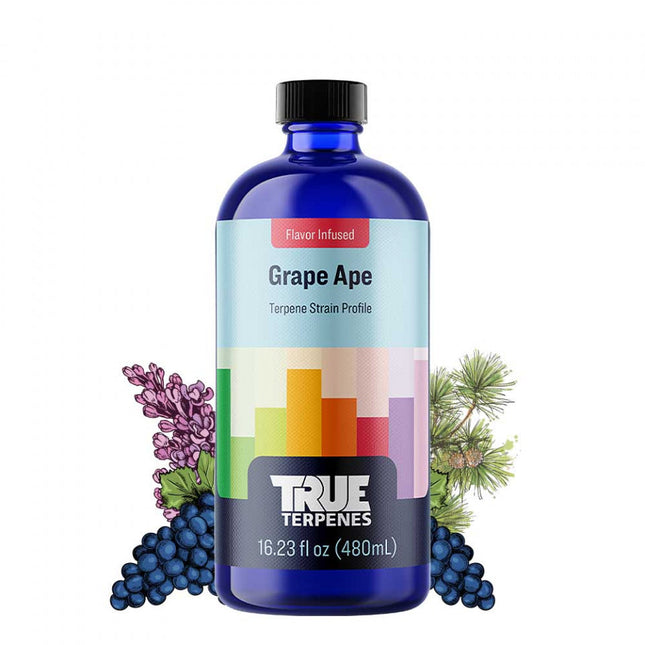
True Terpenes Grape Ape
True Terpenes Grape Ape Fragrance: Grape Berry Lavender Pine Effects: Peaceful Serene The Grape Ape cultivar that inspired our terpene profile is descended from cultivars as varied as Mendocino Purps, Skunk, and a legendary Afghani landrace. The combination of these parents has created a profile that gives the aroma of grapes, tropical fruit, earth and a pine forest. These varied smells merge into a soothing wave. Linalool and ocimene lend a hand with floral, fruity tones and enhance the chill vibe of myrcene. Storage Requirements: Keep in original container, lid securely tightened and away from heat, open flames, sunlight, combustible materials and hot surfaces. No Smoking. Store in a cool dry place. Improper storage can cause terpenes to degrade. Dilution: Terpene Strain & Flavor-Infused Strain Profiles, Effects-Based Terpene Profiles & Terpene Flavors:The Terpene products above must be diluted prior to use. (1-5% by total volume). Terpenes are oil soluble and mix well with plant extracts, coconut oil, and more. Viscosity Extract Modifier: The Terpene product above must be diluted prior to use. (1-3% by total volume). Terpenes are oil soluble and mix well with plant extracts, coconut oil, and more. Handle With Care: Can cause skin irritation, do not use PRIOR to dilution. Grape Ape-Specific Certificates: Product Specification Certificate of Analysis Safety Data Sheet Food Safety Company-Specific Certificates: ISO 9001:2015 GMP Certification FSSC 22000
$170.14 - $3,150.82
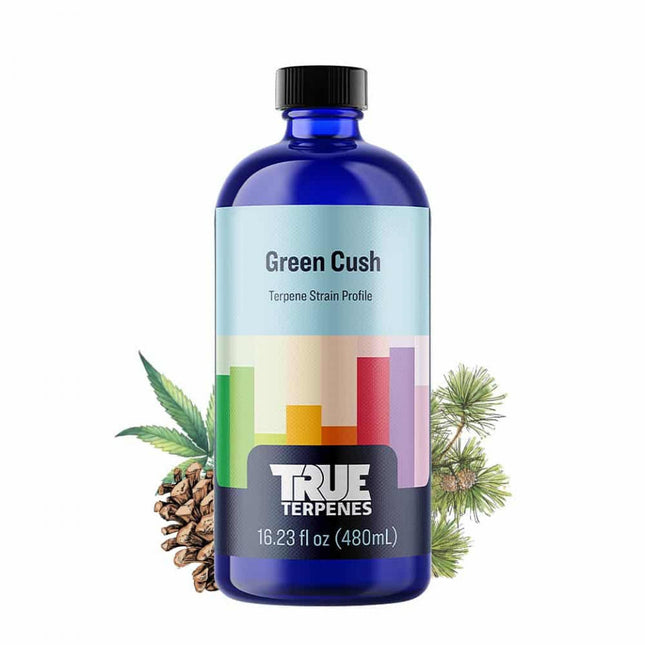
True Terpenes Green Cush
True Terpenes Green Cush Fragrance: Earthy Sweet Citrus Wood Floral Gas Effects: Focus Creative Green Cush is a refreshing hybrid profile with earth, citrus, and wood notes accented with a hint of mint. Storage Requirements: Keep in original container, lid securely tightened and away from heat, open flames, sunlight, combustible materials and hot surfaces. No Smoking. Store in a cool dry place. Improper storage can cause terpenes to degrade. Dilution: Terpene Strain & Flavor-Infused Strain Profiles, Effects-Based Terpene Profiles & Terpene Flavors:The Terpene products above must be diluted prior to use. (1-5% by total volume). Terpenes are oil soluble and mix well with plant extracts, coconut oil, and more. Viscosity Extract Modifier: The Terpene product above must be diluted prior to use. (1-3% by total volume). Terpenes are oil soluble and mix well with plant extracts, coconut oil, and more. Handle With Care: Can cause skin irritation, do not use PRIOR to dilution. Green Cush-Specific Certificates: Certificate of Analysis Safety Data Sheet Food Safety Company-Specific Certificates: ISO 9001:2015 GMP Certification FSSC 22000
$170.14 - $3,150.82
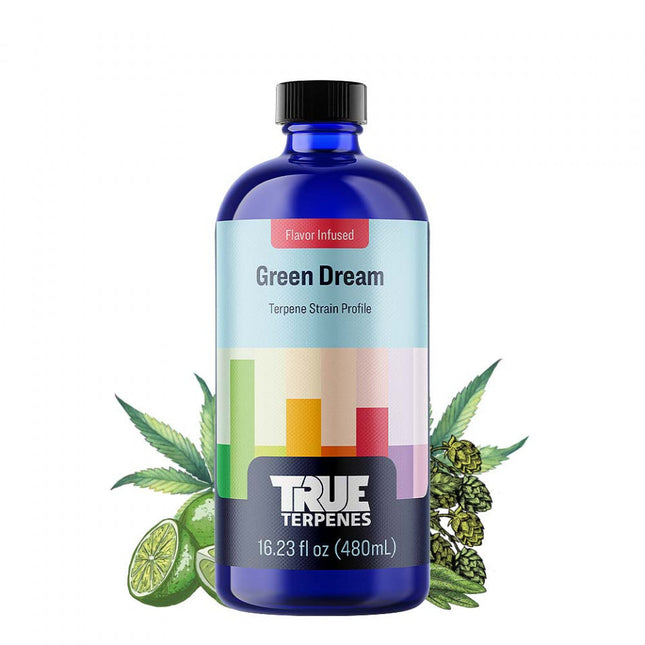
True Terpenes Green Dream
True Terpenes Green Dream Fragrance: Mint Citrus Floral Effects: Creative Uplifting Soothing Green Dream excites with cooling and crisp flavors. Lime and sweet citrus complement a cooling herbal mint sensation. Citrus and fresh herbal notes form the base for this flavor and help give your creativity a boost. Storage Requirements: Keep in original container, lid securely tightened and away from heat, open flames, sunlight, combustible materials and hot surfaces. No Smoking. Store in a cool dry place. Improper storage can cause terpenes to degrade. Dilution: Terpene Strain & Flavor-Infused Strain Profiles, Effects-Based Terpene Profiles & Terpene Flavors:The Terpene products above must be diluted prior to use. (1-5% by total volume). Terpenes are oil soluble and mix well with plant extracts, coconut oil, and more. Viscosity Extract Modifier: The Terpene product above must be diluted prior to use. (1-3% by total volume). Terpenes are oil soluble and mix well with plant extracts, coconut oil, and more. Handle With Care: Can cause skin irritation, do not use PRIOR to dilution. Green Dream-Specific Certificates: Product Specification Certificate of Analysis Safety Data Sheet Food Safety Company-Specific Certificates: ISO 9001:2015 GMP Certification FSSC 22000
$170.14 - $3,150.82
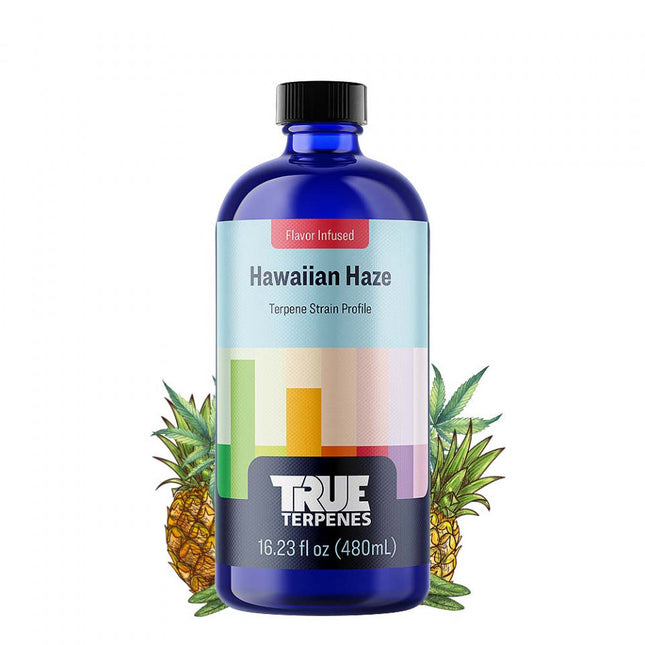
True Terpenes Hawaiian Haze
True Terpenes Hawaiian Haze Fragrance: Pineapple Coconut Mango Citrus Effects: Soothing Uplifting Hawaiian Haze will have you thinking of your next trip to the islands or that summer you spent by the pool. Hawaiian Haze has a heavy base of coconut and pineapple and layers mango and citrus notes on top. Storage Requirements: Keep in original container, lid securely tightened and away from heat, open flames, sunlight, combustible materials and hot surfaces. No Smoking. Store in a cool dry place. Improper storage can cause terpenes to degrade. Dilution: Terpene Strain & Flavor-Infused Strain Profiles, Effects-Based Terpene Profiles & Terpene Flavors:The Terpene products above must be diluted prior to use. (1-5% by total volume). Terpenes are oil soluble and mix well with plant extracts, coconut oil, and more. Viscosity Extract Modifier: The Terpene product above must be diluted prior to use. (1-3% by total volume). Terpenes are oil soluble and mix well with plant extracts, coconut oil, and more. Handle With Care: Can cause skin irritation, do not use PRIOR to dilution. Hawaiian Haze-Specific Certificates: Product Specification Certificate of Analysis Safety Data Sheet Food Safety Company-Specific Certificates: ISO 9001:2015 GMP Certification FSSC 22000
$170.14 - $3,150.82
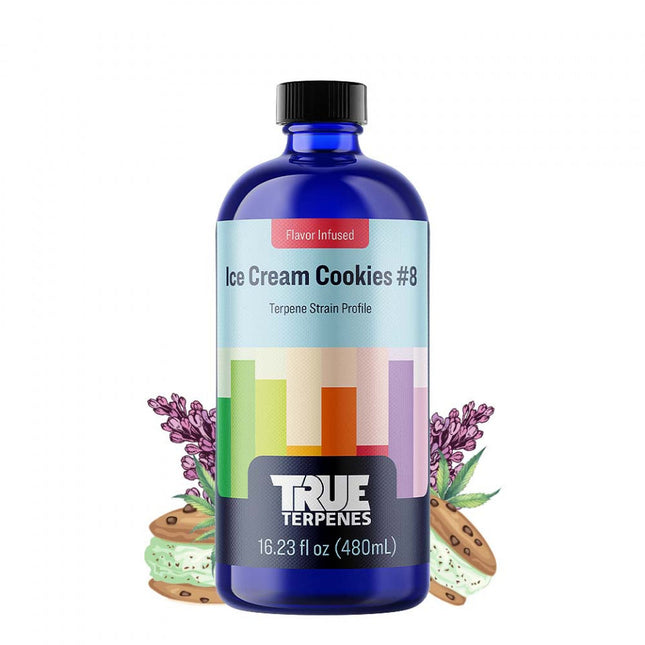
True Terpenes Ice Cream Cookies #8
True Terpenes Ice Cream Cookies #8 Fragrance: Vanilla Cream Lavender Pepper Effects: Serene Uplifting Ice Cream Cookies #8 brings decadent sweet vanilla and coconut aromas that evoke a rich creamy taste. Peppery, lavender and citrus notes blend together to create an earthy floral deliciousness. Storage Requirements: Keep in original container, lid securely tightened and away from heat, open flames, sunlight, combustible materials and hot surfaces. No Smoking. Store in a cool dry place. Improper storage can cause terpenes to degrade. Dilution: Terpene Strain & Flavor-Infused Strain Profiles, Effects-Based Terpene Profiles & Terpene Flavors:The Terpene products above must be diluted prior to use. (1-5% by total volume). Terpenes are oil soluble and mix well with plant extracts, coconut oil, and more. Viscosity Extract Modifier: The Terpene product above must be diluted prior to use. (1-3% by total volume). Terpenes are oil soluble and mix well with plant extracts, coconut oil, and more. Handle With Care: Can cause skin irritation, do not use PRIOR to dilution. Ice Cream Cookies #8-Specific Certificates: Product Specification Certificate of Analysis Safety Data Sheet Food Safety Company-Specific Certificates: ISO 9001:2015 GMP Certification FSSC 22000
$170.14 - $3,150.82
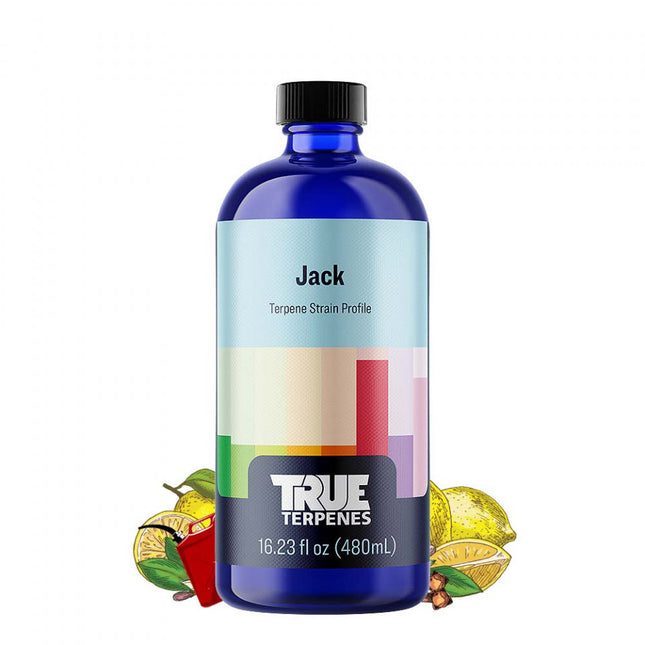
True Terpenes Jack
True Terpenes Jack All sales are final. Orders can be refunded prior to fulfillment and shipping but once the order has been fulfilled and/or shipped, no refunds will be issued. Due to the hazardous nature of our product, we are unable to accept returns. (Please Note: This product has 2 week lead time) Fragrance: Gas Lemon Clove Effects: Uplifting Insightful Named for a legendary activist, this profile is a legend itself. Heavy fuel aroma spills out with pepper, citrus balancing it out. Storage Requirements: Keep in original container, lid securely tightened and away from heat, open flames, sunlight, combustible materials and hot surfaces. No Smoking. Store in a cool dry place. Improper storage can cause terpenes to degrade. Dilution: Terpene Strain & Flavor-Infused Strain Profiles, Effects-Based Terpene Profiles & Terpene Flavors:The Terpene products above must be diluted prior to use. (1-5% by total volume). Terpenes are oil soluble and mix well with plant extracts, coconut oil, and more. Viscosity Extract Modifier: The Terpene product above must be diluted prior to use. (1-3% by total volume). Terpenes are oil soluble and mix well with plant extracts, coconut oil, and more. Handle With Care: Can cause skin irritation, do not use PRIOR to dilution. Jack-Specific Certificates: Product Specification Certificate of Analysis Safety Data Sheet Food Safety Company-Specific Certificates: ISO 9001:2015 GMP Certification FSSC 22000
$170.14 - $3,150.82
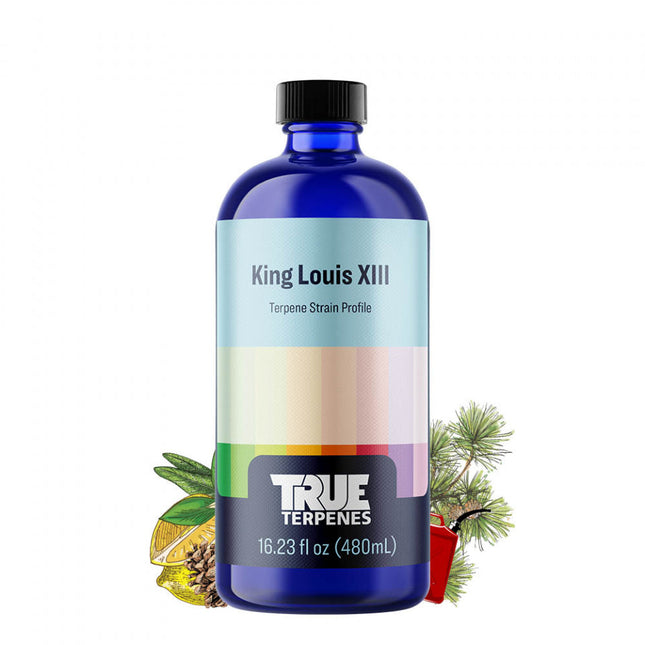
True Terpenes King Louis XIII
True Terpenes King Louis XIII Fragrance: Citrus Earthy Pine Fuel Effects: Function Soothing A California creation, King Louis XIII was bred by combining two popular varieties; OG Kush and LA Confidential. It’s a rare OG Kush variant that has seen limited distribution outside the West Coast. In traditional OG fashion, King Louis has an earthy pine fragrance with layers of fuel and funk. King Louis also provides a heavy citrus dimension. Storage Requirements: Keep in original container, lid securely tightened and away from heat, open flames, sunlight, combustible materials and hot surfaces. No Smoking. Store in a cool dry place. Improper storage can cause terpenes to degrade. Dilution: Terpene Strain & Flavor-Infused Strain Profiles, Effects-Based Terpene Profiles & Terpene Flavors:The Terpene products above must be diluted prior to use. (1-5% by total volume). Terpenes are oil soluble and mix well with plant extracts, coconut oil, and more. Viscosity Extract Modifier: The Terpene product above must be diluted prior to use. (1-3% by total volume). Terpenes are oil soluble and mix well with plant extracts, coconut oil, and more. Handle With Care: Can cause skin irritation, do not use PRIOR to dilution. King Louis XIII-Specific Certificates: Product Specification All Natural Certificate of Analysis Safety Data Sheet Food Safety Company-Specific Certificates: ISO 9001:2015 GMP Certification FSSC 22000
$170.14 - $3,150.82
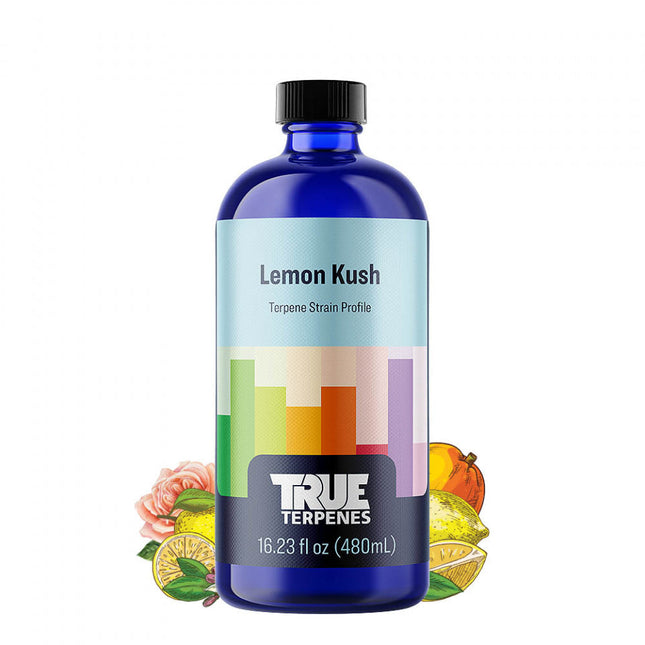
True Terpenes Lemon Kush
True Terpenes Lemon Kush Fragrance: Lemon Mango Pepper Florals Effects: Soothing Focused Lemon Kush brings the tangy sweet of lemons together with the skunky, earthy flavors that Kush is known for. The blending continues to the effects. Lemon Kush may put you on the couch, but you’ll be ready to talk. Storage Requirements: Keep in original container, lid securely tightened and away from heat, open flames, sunlight, combustible materials and hot surfaces. No Smoking. Store in a cool dry place. Improper storage can cause terpenes to degrade. Dilution: Terpene Strain & Flavor-Infused Strain Profiles, Effects-Based Terpene Profiles & Terpene Flavors:The Terpene products above must be diluted prior to use. (1-5% by total volume). Terpenes are oil soluble and mix well with plant extracts, coconut oil, and more. Viscosity Extract Modifier: The Terpene product above must be diluted prior to use. (1-3% by total volume). Terpenes are oil soluble and mix well with plant extracts, coconut oil, and more. Handle With Care: Can cause skin irritation, do not use PRIOR to dilution. Lemon Kush-Specific Certificates: Product Specification All Natural Certificate of Analysis Safety Data Sheet Food Safety Company-Specific Certificates: ISO 9001:2015 GMP Certification FSSC 22000
$170.14 - $3,150.82
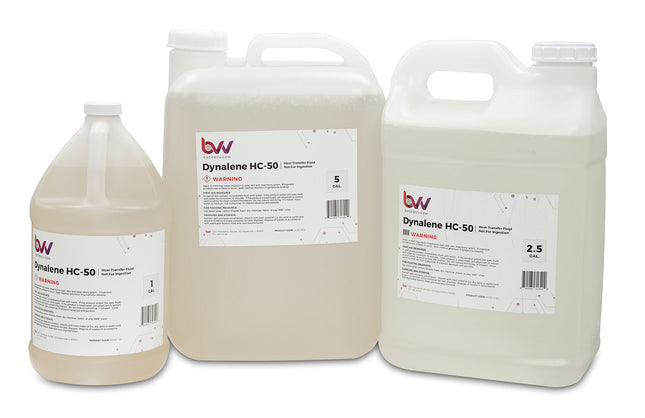
Dynalene HC-50 Heat Transfer Fluid
Dynalene HC-50 Dynalene HC/Potassium Formate is a water-based, low-temperature heat transfer fluid engineered to deliver the excellent heat transfer performance in applications down to -58°F (-50°C). With the temperature range -50°C to +218°C, Dynalene HC easily exceeds the performance of other water-based chemistries such as glycol /water mixtures, calcium chloride/water as well as hydrocarbon and silicone-based fluids. The fluid comes in five concentrations and is non-toxic, non-hazardous and non-flammable. Effective Calcium Chloride Alternative Dynalene HC/Potassium Formate heat transfer fluid is an excellent alternative to calcium chloride and other brine solutions because it demonstrates a higher thermal efficiency and lower corrosion rate. This fluid, as compared to other glycols, calcium chloride, and other brine solutions, should lower the leak and spillage rate, and reduce maintenance and repair costs on refrigerated systems. This is due to Dynalene HC's use of "safe" chemistries resulting in a high level of corrosion inhibition. The viscosity of calcium chloride solutions is also noticeably higher than Dynalene HC heat transfer fluid, which in turn makes Dynalene HC a more thermally efficient solution. Key Features: 100% Biodegradeable Non-Toxic Non-flammable Aqueous-Based Superior heat transfer characteristics Attractive alternative to glycols and brines Applications: Pharmaceutical process Food and beverage Chemical process Climatic Chamber LPG Processing Low-Temperature Baths Temperature Range: Open systems: HC-50: -51°C (-60°F) to 110°C (230°F)Closed Systems: HC-50: -50°C (-58°F) to 218°C (425°F) Technical Data Sheet MSDS Engineering Guide
$168.04 - $18,904.93
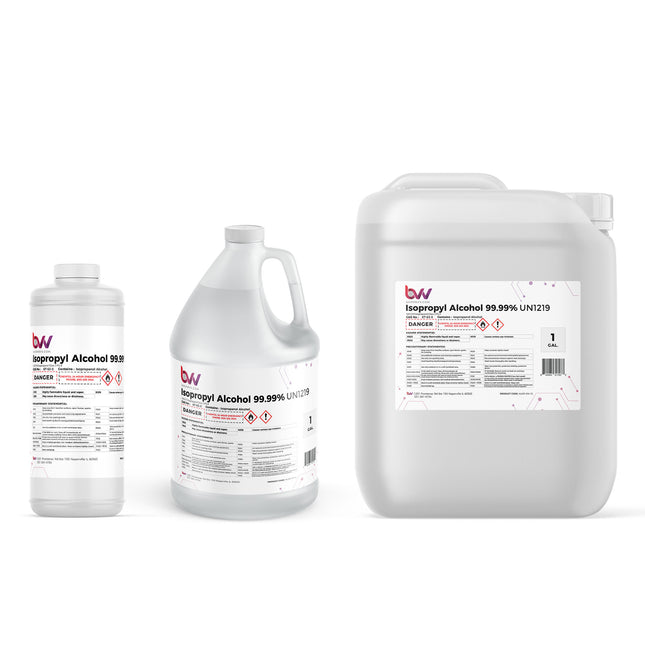
Isopropyl Alcohol 99% Tech Grade
Isopropyl Alcohol IPA 99% Isopropyl alcohol, also known as 2-propanol or rubbing alcohol, is one of the most common alcohol solutions. The exact mechanism behind isopropanol’s disinfectant is not certain, however, it’s believed to kill cells through the process of denaturing cell proteins and DNA, dissolving cell lipoprotein membranes, and obstructing cellular metabolism. Isopropanol has a range of applications and uses across multiple industries, from medicine to cosmetics, and we explore this below. Cleaning Agent for Extraction, Laboratory, and Medical Industries In addition, 99% pure isopropyl alcohol serves as a cleaning agent for the laboratory, medical, and extraction industries. Mixed with water, this solution can be used as a rubbing-alcohol antiseptic. Quality solvents are vital for cleaning delicate electronics, extraction equipment, and other sensitive items. It also makes a perfect solution for surface disinfectant. 99% IPA evaporates cleanly and minimizes residual substances. Cleaning Agent for Home Care A truly versatile solution used in a variety of applications, isopropyl can also serve as a home cleaning remedy. For example, many window and toilet bowl cleaners contain isopropyl alcohol. rubbing alcohol can dissolve icky residues such as chewing gum, sap, hairspray, and other difficult compounds from hands, surfaces, and more. Other ways isopropyl can be used: Cleaning makeup brushes Cleaning blinds Cleaning sinks and chrome Deodorizing shoes Disinfecting computer mouse and keyboard Disinfecting mobile phone Dissolving windshield frost Getting rid of fruit flies Cleaning jewelry Creating homemade sanitizer Preventing ring around the collar Cleaning stainless steel Other Things to Note Spigots/Faucets are only compatible with 5 Gallon Jugs and must be purchased separately Isopropyl alcohol is a fast-evaporating solvent and industrial cleaning agent, intended for industrial or professional use only. It can be used as a solvent for gums, shellac, and essential oils. Can be used as a fuel additive. Isopropyl Alcohol (liquid) - 99.8% Purity Shelf Life - 5 years Specific Gravity - 0.79 Vapor Pressure - 1psi @ 20°C Flash Point - 12°C Boiling Point - 82°C *Disclaimer: 1 Quart Bottles are exempt from additional Hazmat shipping charges and can ship immediately, Less paperwork for shipping is required for shipping only 1 single bottle per order. BVV™ Isopropyl Alcohol SDS BVV™ Isopropyl Alcohol COA Chemical Formula: C3H8O Molecular Weight: 60.096 g/mol CAS Registry Number: 67-63-0 Appearance Colorless Liquid Odor: Pungent Alcoholic odor Density 0.786 g/cm3 (20 °C) Boiling Point: 82.6 °C /180.7 °F Solubility in water: miscible GHS Pictograms: GHS Signal Word: Danger GHS Hazard Statements: H225, H302, H319, H336 GHS Precautionary Statements P210, P261, P305+P351+P338 UN Identification Number: 1219 Proper Shipping Name: Isopropanol Transport Hazard Class: 3 Packing Group: II DOT Placard:
$22.41 - $5,034.31
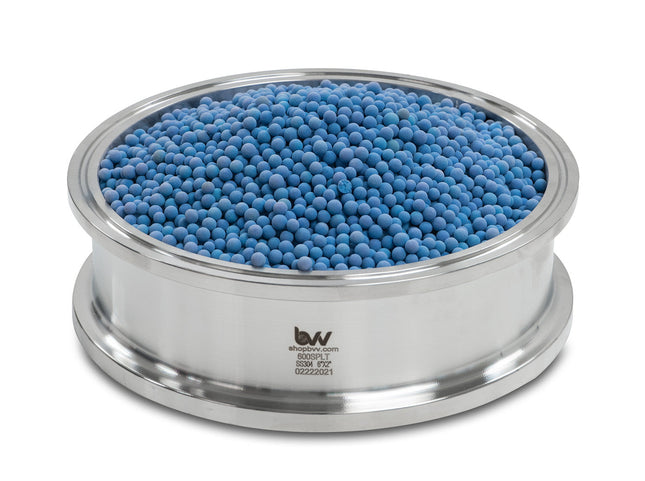
Indicating Molecular Sieve Beads Type 4A
Indicating Molecular Sieve Beads TYPE 4A (Blue) Description: 4A Blue Indicating Molecular Sieve is a porous, high capacity alkali metal aluminosilicate compound. Like non-indicating 4A molecular sieve, our blue indicating 4A molecular sieve has 4 Angstrom-sized pore openings that allow to adsorb all molecules adsorbed by 3A, molecular sieve, plus larger molecules like aromatic and branched-chain hydrocarbons. Handling & Storage Recommendations: Store in a dry location to prevent unintentional water adsorption. Reseal packages after opening to prevent contamination and unintentional water adsorption. We recommend that you rotate stock so the oldest material is used first. Please read the safety data sheet to ensure proper handling and always wear personal protection equipment when handling molecular sieve. Molecular Sieve 4A Indicating Technical Data Sheet Molecular Sieve 4A Indicating Technical Data Sheet
$22.41 - $1,365.36
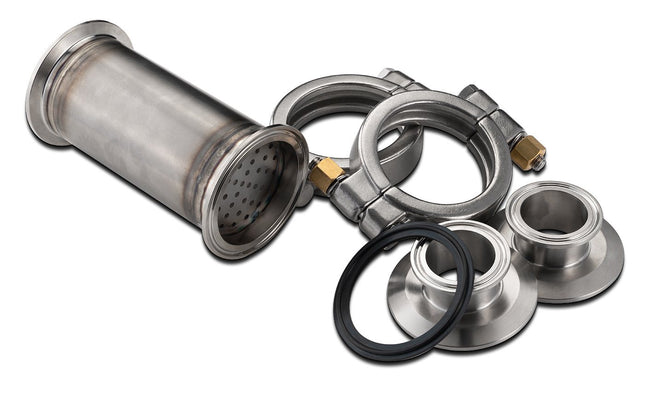
AFS Tri-Clamp Inline Filter Housing for Disposable Color Remediation Cartridges
AFS Tri-Clamp Inline Filter Housing for Disposable Color Remediation Cartridges Note: Disposable cartridges sold separately. (Click Here for Cartridges) This inline housing allows for implementation of the AFS filters into many extraction systems. The AFS filter housing is 2.5" but comes with the adapter flanges for both ends to go inline with a standard 1.5" or 2" tri-clamp system. Kit Includes 2x 2.5" High Pressure Clamps 1x 2.5" Buna-N Gasket 2x Reducers 2.5" to 1.5" or 2" Tri-clamp 1x Cartridge Housing AFS Instruction Manual Download Here AFS SDS Sheet
$280.07$224.06
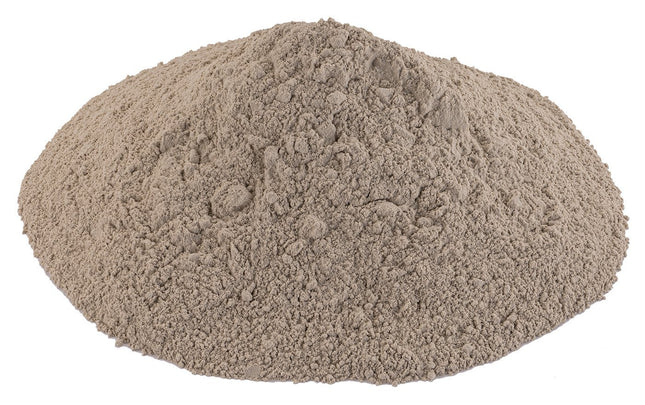
Perform 6000 Highly Activated Bleaching & Decolorizing Bentonite
Highly Activated Bentonite Clay for Bleaching & Decolorizing Edible Oils pH: 2.5 Pure-Flo® Perform 6000 is a highly activated bentonite clay that is used to purify extremely difficult to bleach oils with the most challenging levels of chlorophyll and color bodies. Particle Size: 325 Mesh Color: Beige Performance Features & Benefits: Filter Aid Removes phosolipids Excellent Metal adsorption (P, Ca, Fe, Mg, etc.) Effective with all types of difficult-to-bleach oil Top chlorophyll removal in its class & improved red color reduction pH 2.5 FDA GRAS (Generally Recognized as Safe) - This product is safe for processing food, as long as its not part of the end product being consumed. Pure-Flo® Perform 6000 Data Sheet.pdf Pure-Flo® Perform 6000 Safety Data Sheet (SDS).pdf Note: Bulk Bags and Bulk sizes are non-stocked items and will be ordered as needed and carry a several weeks lead time and require a forklift or pallet jack Note: Container style and color may vary. Product is sold by weight which may result in container not being full.
$28.01 - $3,255.85
You have seen 144 out of 217 products
















































